

Animals are in Danger of Extinction IELTS Essay
Animals are in danger of extinction. Some people say that we should protect only those animals, which are useful to humans. To what extent do you agree or disagree?
Give reasons for your answer and include any relevant examples from your own knowledge or experience. You should write at least 250 words.
Real IELTS Exam Question, Reported On:
Practice with Expert IELTS Tutors Online
Apply Code "IELTSXPRESS20" To Get 20% off on IELTS Mock Test
Animal extinction has become a matter of great concern. I disagree with the given statement that we Animal extinction has become a matter of great concern. I disagree with the given statement that we should conserve only those animals, which are beneficial to humans. I believe that all animals have direct or indirect effect on mankind. It has been rightly said that plans to protect wildlife are in fact plans to protect man.
The most important reason for saving all animals is that they are part of our ecosystem. Every species of wildlife plays a role to maintain the balance of life on Earth. Thus, the loss of any species can affect us directly or indirectly. For example, there are many bat species that are becoming extinct. Such bats help keep the insect population in control. If these bats die then the insects will increase a lot and destroy our crops. So, we will have nothing to eat. In addition, many animals, like rodents, help in the dispersal of plant seeds and in the pollination of plants. By protecting endangered animals we ensure not only their survival but also the biodiversity that is necessary for the ecological health of the planet.
Secondly, wild animals provide many valuable substances such as medicine and fur. The horn of the rhinoceros has medicinal value and the fur of the mink is very valuable. The recreational viewing of animals at zoos is also a source of revenue. Thus, the financial value of wild species is important to the economies of many nations.
Furthermore, wild animals have aesthetic appeal. They are beautiful creatures of nature and are a part of our bio-diversity. Their beautiful and mysterious life has enchanted mankind since the dawn of evolution. Scientists have been awed, by observing their behaviour. Such study has helped scientists understand how the human body functions and why people behave as they do. Scientists have also gained medical knowledge by studying the effect of many drugs on these animals.
Finally, it is undeniable that animal species have been vanishing at a much faster rate for about a century now due to human factors such as pollution, commercial over exploitation, poaching and deforestation. Knowingly or unknowingly, we humans are doing so much damage to plants and animals that working for their conservation has become a necessity.
To sum up, it can be reiterated that saving all the animal species on the verge of extinction is well justified. All animals have direct or indirect relation to humans. So we should not work to save only those few species, which have a visible effect on humans.
IELTS Essay on Animal Extinction
These days, the number of endangered species has reached an alarming stage. While some people think that people should only protect those animals that are useful to us, I completely disagree with this idea and believe that we should try to protect all species, even if there are those who consider them useless. This essay will present arguments in support of my opinion.
To begin with, I believe that a large number of endangered animals are due to human activities. For instance, deforestation and burning forest are two major factors that have driven dozens of species to extinction. Therefore, there is nothing more just than to protect those animals that we put in such a position, regardless of whether they are useful to humans or not. Furthermore, we may think that some species are not useful nowadays, but we are not able to predict the future and that some species that we classify as unusable will be in the future.

Moreover, each animal plays an important role in the environment. In other words, each individual species is extremely important for maintaining balance in the animal kingdom. For example, the extinction of a single animal can lead to serious trouble for others. This is because every animal has a place in the animal web, with some being prey and others being predators. If one of them goes missing, the entire system could be in danger.
In conclusion, I believe that people should be concerned about the protection of all kinds of animals. Not only because they are important to the environment, but also because some of them are endangered due to human activity.
Also Check: Changing Lifestyle and Family Relationships IELTS Essay
Oh hi there! It’s nice to meet you.
Sign up to receive awesome content in your inbox, every week.
We promise not to spam you or share your Data. 🙂
Check your inbox or spam folder to confirm your subscription.

Oh Hi there! It’s nice to meet you.
We promise not to Spam or Share your Data. 🙂
Related Posts

Recent IELTS Exam 13 April 2024 India Question Answers

Pacific Navigation and Voyaging IELTS Reading

Recent IELTS Exam 23 March 2024 India Question Answers
Leave a comment cancel reply.
Your email address will not be published. Required fields are marked *
Yes, add me to your mailing list
Start typing and press enter to search
Endangered Species
An endangered species is a type of organism that is threatened by extinction. Species become endangered for two main reasons: loss of habitat and loss of genetic variation.
Biology, Ecology, Geography, Conservation
Loading ...

An endangered species is a type of organism that is threatened by extinction . Species become endangered for two main reasons: loss of habitat and loss of genetic variation . Loss of Habitat A loss of habitat can happen naturally. Nonavian dinosaurs , for instance, lost their habitat about 65 million years ago. The hot, dry climate of the Cretaceous period changed very quickly, most likely because of an asteroid striking Earth. The impact of the asteroid forced debris into the atmosphere , reducing the amount of heat and light that reached Earth’s surface. The dinosaurs were unable to adapt to this new, cooler habitat. Nonavian dinosaurs became endangered, then extinct . Human activity can also contribute to a loss of habitat. Development for housing, industry , and agriculture reduces the habitat of native organisms. This can happen in a number of different ways. Development can eliminate habitat and native species directly. In the Amazon rainforest of South America, developers have cleared hundreds of thousands of acres. To “clear” a piece of land is to remove all trees and vegetation from it. The Amazon rainforest is cleared for cattle ranches , logging , and ur ban use. Development can also endanger species indirectly. Some species, such as fig trees of the rainforest, may provide habitat for other species. As trees are destroyed, species that depend on that tree habitat may also become endangered. Tree crowns provide habitat in the canopy , or top layer, of a rainforest . Plants such as vines, fungi such as mushrooms, and insects such as butterflies live in the rainforest canopy. So do hundreds of species of tropical birds and mammals such as monkeys. As trees are cut down, this habitat is lost. Species have less room to live and reproduce . Loss of habitat may happen as development takes place in a species range . Many animals have a range of hundreds of square kilometers. The mountain lion ( Puma concolor ) of North America, for instance, has a range of up to 1,000 square kilometers (386 square miles). To successfully live and reproduce, a single mountain lion patrols this much territory. Urban areas , such as Los Angeles, California, U.S.A., and Vancouver, British Columbia, Canada, grew rapidly during the 20th century. As these areas expanded into the wilderness, the mountain lion’s habitat became smaller. That means the habitat can support fewer mountain lions. Because enormous parts of the Sierra Nevada, Rocky, and Cascade mountain ranges remain undeveloped, however, mountain lions are not endangered. Loss of habitat can also lead to increased encounters between wild species and people. As development brings people deeper into a species range, they may have more exposure to wild species. Poisonous plants and fungi may grow closer to homes and schools. Wild animals are also spotted more frequently . These animals are simply patrolling their range, but interaction with people can be deadly. Polar bears ( Ursus maritimus ), mountain lions, and alligators are all predators brought into close contact with people as they lose their habitat to homes, farms , and businesses. As people kill these wild animals, through pesticides , accidents such as collisions with cars, or hunting, native species may become endangered.
Loss of Genetic Variation Genetic variation is the diversity found within a species. It’s why human beings may have blond, red, brown, or black hair. Genetic variation allows species to adapt to changes in the environment. Usually, the greater the population of a species, the greater its genetic variation. Inbreeding is reproduction with close family members. Groups of species that have a tendency to inbreed usually have little genetic variation, because no new genetic information is introduced to the group. Disease is much more common, and much more deadly, among inbred groups. Inbred species do not have the genetic variation to develop resistance to the disease. For this reason, fewer offspring of inbred groups survive to maturity. Loss of genetic variation can occur naturally. Cheetahs ( Acinonyx jubatus ) are a threatened species native to Africa and Asia. These big cats have very little genetic variation. Biologists say that during the last Ice Age , cheetahs went through a long period of inbreeding. As a result, there are very few genetic differences between cheetahs. They cannot adapt to changes in the environment as quickly as other animals, and fewer cheetahs survive to maturity. Cheetahs are also much more difficult to breed in captivity than other big cats, such as lions ( Panthera leo ). Human activity can also lead to a loss of genetic variation. Overhunting and overfishing have reduced the populations of many animals. Reduced population means there are fewer breeding pairs . A breeding pair is made up of two mature members of the species that are not closely related and can produce healthy offspring. With fewer breeding pairs, genetic variation shrinks. Monoculture , the agricultural method of growing a single crop , can also reduce genetic variation. Modern agribusiness relies on monocultures. Almost all potatoes cultivated , sold, and consumed, for instance, are from a single species, the Russet Burbank ( Solanum tuberosum ). Potatoes, native to the Andes Mountains of South America, have dozens of natural varieties. The genetic variation of wild potatoes allows them to adapt to climate change and disease. For Russet Burbanks, however, farmers must use fertilizers and pesticides to ensure healthy crops because the plant has almost no genetic variation. Plant breeders often go back to wild varieties to collect genes that will help cultivated plants resist pests and drought, and adapt to climate change. However, climate change is also threatening wild varieties. That means domesticated plants may lose an important source of traits that help them overcome new threats. The Red List The International Union for Conservation of Nature (IUCN) keeps a “Red List of Threatened Species.” The Red List de fines the severity and specific causes of a species’ threat of extinction. The Red List has seven levels of conservation: least concern , near threatened , vulnerable, endangered, critically endangered , extinct in the wild , and extinct. Each category represents a different threat level. Species that are not threatened by extinction are placed within the first two categories—least concern and near-threatened. Those that are most threatened are placed within the next three categories, known as the threatened categories —vulnerable, endangered, and critically endangered. Those species that are extinct in some form are placed within the last two categories—extinct in the wild and extinct. Classifying a species as endangered has to do with its range and habitat, as well as its actual population. For this reason, a species can be of least concern in one area and endangered in another. The gray whale ( Eschrichtius robustus ), for instance, has a healthy population in the eastern Pacific Ocean, along the coast of North and South America. The population in the western Pacific, however, is critically endangered.
Least Concern Least concern is the lowest level of conservation . A species of least concern is one that has a widespread and abundant population. Human beings are a species of least concern, along with most domestic animals , such as dogs ( Canis familiaris ) and cats ( Felis catus ). Many wild animals, such as pigeons and houseflies ( Musca domestica ), are also classified as least concern. Near Threatened A near threatened species is one that is likely to qualify for a threatened category in the near future. Many species of violets , native to tropical jungles in South America and Africa, are near threatened, for instance. They have healthy populations, but their rainforest habitat is disappearing at a fast pace. People are cutting down huge areas of rainforest for development and timber . Many violet species are likely to become threatened. Vulnerable Species The definitions of the three threatened categories (vulnerable, endangered, and critically endangered) are based on five criteria: population reduction rate , geographic range, population size, population restrictions , and probability of extinction . Threatened categories have different thresholds for these criteria. As the population and range of the species decreases, the species becomes more threatened. 1) Population reduction rate A species is classified as vulnerable if its population has declined between 30 and 50 percent. This decline is measured over 10 years or three generations of the species, whichever is longer. A generation is the period of time between the birth of an animal and the time it is able to reproduce. Mice are able to reproduce when they are about one month old. Mouse populations are mostly tracked over 10-year periods. An elephant's generation lasts about 15 years. So, elephant populations are measured over 45-year periods. A species is vulnerable if its population has declined at least 50 percent and the cause of the decline is known. Habitat loss is the leading known cause of population decline. A species is also classified as vulnerable if its population has declined at least 30 percent and the cause of the decline is not known. A new, unknown virus , for example, could kill hundreds or even thousands of individuals before being identified. 2) Geographic range A species is vulnerable if its “ extent of occurrence ” is estimated to be less than 20,000 square kilometers (7,722 square miles). An extent of occurrence is the smallest area that could contain all sites of a species’ population. If all members of a species could survive in a single area, the size of that area is the species’ extent of occurrence. A species is also classified as vulnerable if its “ area of occupancy ” is estimated to be less than 2,000 square kilometers (772 square miles). An area of occupancy is where a specific population of that species resides. This area is often a breeding or nesting site in a species range. 3) Population size Species with fewer than 10,000 mature individuals are vulnerable. The species is also vulnerable if that population declines by at least 10 percent within 10 years or three generations, whichever is longer. 4) Population restrictions Population restriction is a combination of population and area of occupancy. A species is vulnerable if it is restricted to less than 1,000 mature individuals or an area of occupancy of less than 20 square kilometers (8 square miles). 5) Probability of extinction in the wild is at least 10 percent within 100 years. Biologists, anthropologists, meteorologists , and other scientists have developed complex ways to determine a species’ probability of extinction. These formulas calculate the chances a species can survive, without human protection, in the wild. Vulnerable Species: Ethiopian Banana Frog The Ethiopian banana frog ( Afrixalus enseticola ) is a small frog native to high- altitude areas of southern Ethiopia. It is a vulnerable species because its area of occupancy is less than 2,000 square kilometers (772 square miles). The extent and quality of its forest habitat are in decline. Threats to this habitat include forest clearance, mostly for housing and agriculture. Vulnerable Species: Snaggletooth Shark The snaggletooth shark ( Hemipristis elongatus ) is found in the tropical, coastal waters of the Indian and Pacific Oceans. Its area of occupancy is enormous, from Southeast Africa to the Philippines, and from China to Australia. However, the snaggletooth shark is a vulnerable species because of a severe population reduction rate. Its population has fallen more than 10 percent over 10 years. The number of these sharks is declining due to fisheries, especially in the Java Sea and Gulf of Thailand. The snaggletooth shark’s flesh, fins, and liver are considered high-quality foods. They are sold in commercial fish markets, as well as restaurants. Vulnerable Species: Galapagos Kelp Galapagos kelp ( Eisenia galapagensis ) is a type of seaweed only found near the Galapagos Islands in the Pacific Ocean. Galapagos kelp is classified as vulnerable because its population has declined more than 10 percent over 10 years. Climate change is the leading cause of decline among Galapagos kelp. El Niño, the natural weather pattern that brings unusually warm water to the Galapagos, is the leading agent of climate change in this area. Galapagos kelp is a cold-water species and does not adapt quickly to changes in water temperature.
Endangered Species 1) Population reduction rate A species is classified as endangered when its population has declined between 50 and 70 percent. This decline is measured over 10 years or three generations of the species, whichever is longer. A species is classified as endangered when its population has declined at least 70 percent and the cause of the decline is known. A species is also classified as endangered when its population has declined at least 50 percent and the cause of the decline is not known. 2) Geographic range An endangered species’ extent of occurrence is less than 5,000 square kilometers (1,930 square miles). An endangered species’ area of occupancy is less than 500 square kilometers (193 square miles). 3) Population size A species is classified as endangered when there are fewer than 2,500 mature individuals. When a species population declines by at least 20 percent within five years or two generations, it is also classified as endangered. 4) Population restrictions A species is classified as endangered when its population is restricted to less than 250 mature individuals. When a species’ population is this low, its area of occupancy is not considered. 5) Probability of extinction in the wild is at least 20 percent within 20 years or five generations, whichever is longer.
Endangered Species: Scimitar -horned Oryx The scimitar-horned oryx ( Oryx dammah ) is a species of antelope with long horns. Its range extends across northern Africa. Previously, the scimitar-horned oryx was listed as extinct in the wild because the last confirmed sighting of one was in 1988. However, the first group of scimitar-horned oryx was released back into the wild in Chad, in August 2016, and the population is growing. Overhunting and habitat loss, including competition with domestic livestock , are the main reasons for the decline of the oryx’s wild population. Captive herds are now kept in protected areas of Tunisia, Senegal, and Morocco. Scimitar-horned oryxes are also found in many zoos . Critically Endangered Species 1) Population reduction rate A critically endangered species’ population has declined between 80 and 90 percent. This decline is measured over 10 years or three generations of the species, whichever is longer. A species is classified as critically endangered when its population has declined at least 90 percent and the cause of the decline is known. A species is also classified as endangered when its population has declined at least 80 percent and the cause of the decline is not known. 2) Geographic range A critically endangered species’ extent of occurrence is less than 100 square kilometers (39 square miles). A critically endangered species’ area of occupancy is estimated to be less than 10 square kilometers (4 square miles). 3) Population size A species is classified as critically endangered when there are fewer than 250 mature individuals. A species is also classified as critically endangered when the number of mature individuals declines by at least 25 percent within three years or one generation, whichever is longer. 4) Population restrictions A species is classified as critically endangered when its population is restricted to less than 50 mature individuals. When a species’ population is this low, its area of occupancy is not considered. 5) Probability of extinction in the wild is at least 50 percent within 10 years or three generations, whichever is longer. Critically Endangered Species: Bolivian Chinchilla Rat The Bolivian chinchilla rat ( Abrocoma boliviensis ) is a rodent found in a small section of the Santa Cruz region of Bolivia. It is critically endangered because its extent of occurrence is less than 100 square kilometers (39 square miles). The major threat to this species is loss of its cloud forest habitat. People are clearing forests to create cattle pastures .
Critically Endangered Species: Transcaucasian Racerunner The Transcaucasian racerunner ( Eremias pleskei ) is a lizard found on the Armenian Plateau , located in Armenia, Azerbaijan, Iran, and Turkey. The Transcaucasian racerunner is a critically endangered species because of a huge population decline, estimated at more than 80 percent during the past 10 years. Threats to this species include the salination , or increased saltiness, of soil . Fertilizers used for agricultural development seep into the soil, increasing its saltiness. Racerunners live in and among the rocks and soil, and cannot adapt to the increased salt in their food and shelter. The racerunner is also losing habitat as people create trash dumps on their area of occupancy. Critically Endangered Species: White Ferula Mushroom The white ferula mushroom ( Pleurotus nebrodensis ) is a critically endangered species of fungus. The mushroom is critically endangered because its extent of occurrence is less than 100 square kilometers (39 square miles). It is only found in the northern part of the Italian island of Sicily, in the Mediterranean Sea. The leading threats to white ferula mushrooms are loss of habitat and overharvesting. White ferula mushrooms are a gourmet food item. Farmers and amateur mushroom hunters harvest the fungus for food and profit. The mushrooms can be sold for up to $100 per kilogram (2.2 pounds). Extinct in the Wild A species is extinct in the wild when it only survives in cultivation (plants), in captivity (animals), or as a population well outside its established range. A species may be listed as extinct in the wild only after years of surveys have failed to record an individual in its native or expected habitat.
Extinct in the Wild: Monut Kaala Cyanea The Mount Kaala cyanea ( Cyanea superba ) is a large, flowering tree native to the island of Oahu, in the U.S. state of Hawai‘i. The Mount Kaala cyanea has large, broad leaves and fleshy fruit. The tree is extinct in the wild largely because of invasive species. Non-native plants crowded the cyanea out of its habitat, and non-native animals such as pigs, rats, and slugs ate its fruit more quickly than it could reproduce. Mount Kaala cyanea trees survive in tropical nurseries and botanical gardens . Many botanists and conservationists look forward to establishing a new population in the wild. Extinct A species is extinct when there is no reasonable doubt that the last remaining individual of that species has died. Extinct: Cuban Macaw The Cuban macaw ( Ara tricolor ) was a tropical parrot native to Cuba and a small Cuban island, Isla de la Juventud. Hunting and collecting the birds for pets led to the bird’s extinction. The last specimen of the Cuban macaw was collected in 1864. Extinct: Ridley’s Stick Insect Ridley’s stick insect ( Pseudobactricia ridleyi ) was native to the tropical jungle of the island of Singapore. This insect, whose long, segmented body resembled a tree limb, is only known through a single specimen, collected more than 100 years ago. During the 20th century, Singapore experienced rapid development. Almost the entire jungle was cleared, depriving the insect of its habitat.
Endangered Species and People When a species is classified as endangered, governments and international organizations can work to protect it. Laws may limit hunting and destruction of the species’ habitat. Individuals and organizations that break these laws may face huge fines. Because of such actions, many species have recovered from their endangered status. The brown pelican ( Pelecanus occidentalis ) was taken off the endangered species list in 2009, for instance. This seabird is native to the coasts of North America and South America, as well as the islands of the Caribbean Sea. It is the state bird of the U.S. state of Louisiana. In 1970, the number of brown pelicans in the wild was estimated at 10,000. The bird was classified as vulnerable. During the 1970s and 1980s, governments and conservation groups worked to help the brown pelican recover. Young chicks were reared in hatching sites, then released into the wild. Human access to nesting sites was severely restricted. The pesticide DDT , which damaged the eggs of the brown pelican, was banned. During the 1980s, the number of brown pelicans soared. In 1988, the IUCN “delisted” the brown pelican. The bird, whose population is now in the hundreds of thousands, is now in the category of least concern.
Convention on Biological Diversity The Convention on Biological Diversity is an international treaty to sustain and protect the diversity of life on Earth. This includes conservation, sustainability, and sharing the benefits of genetic research and resources. The Convention on Biological Diversity has adopted the IUCN Red List of endangered species in order to monitor and research species' population and habitats. Three nations have not ratified the Convention on Biological Diversity: Andorra, the Holy See (Vatican), and the United States.
Lonesome George Lonesome George was the only living member of the Pinta Island tortoise ( Chelonoidis abingdoni ) known to exist. The Pinta Island tortoise was only found on Pinta, one of the Galapagos Islands. The Charles Darwin Research Station, a scientific facility in the Galapagos, offered a $10,000 reward to any zoo or individual for locating a single Pinta Island tortoise female. On June 25, 2012, Lonesome George died, leaving one more extinct species in the world.
Audio & Video
Articles & profiles, media credits.
The audio, illustrations, photos, and videos are credited beneath the media asset, except for promotional images, which generally link to another page that contains the media credit. The Rights Holder for media is the person or group credited.
Illustrators
Educator reviewer, last updated.
March 8, 2024
User Permissions
For information on user permissions, please read our Terms of Service. If you have questions about how to cite anything on our website in your project or classroom presentation, please contact your teacher. They will best know the preferred format. When you reach out to them, you will need the page title, URL, and the date you accessed the resource.
If a media asset is downloadable, a download button appears in the corner of the media viewer. If no button appears, you cannot download or save the media.
Text on this page is printable and can be used according to our Terms of Service .
Interactives
Any interactives on this page can only be played while you are visiting our website. You cannot download interactives.
Related Resources
Sign up to get the latest WWF news delivered straight to your inbox
10 of the world's most endangered animals
Currently, more than 41,000 species have been assessed to be under threat of extinction according to the IUCN.
As our modern society gets more resource-intensive, natural spaces are shrinking and wildlife numbers are declining. Our 2022 Living Planet Report shows global wildlife populations have plummeted by 69% on average since 1970. While there have been amazing and inspirational wildlife successes and stories in the past, many animals are still endangered mostly due to unsustainable human-led activities. Currently, on the International Union for Conservation of Nature (IUCN) red list, more than 41,000 species have been assessed to be under threat of extinction . And below we’ve listed 10 of the world’s most endangered animals in the wild:
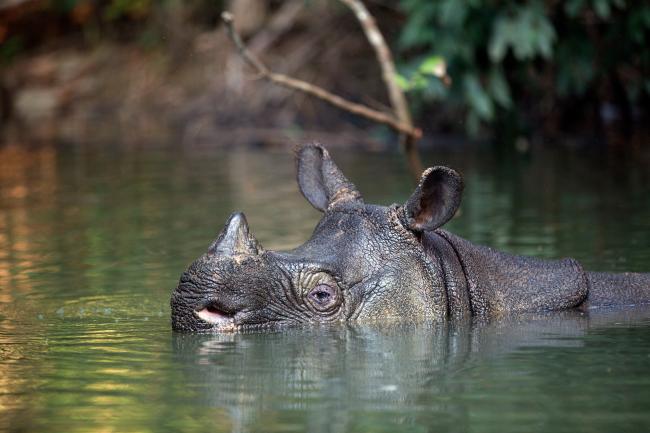
1. Javan Rhinos
Once found throughout south-east Asia, Javan rhinos have suffered a staggering decline in their numbers due to hunting and habitat loss. The lone wild population of Javan rhinos is one of the rarest of the rhino species—around 75 individuals—which can only be found on the island of Java, Indonesia.
The Ujung Kulon National Park, a World Heritage Site, is the last remaining refuge of Javan rhinos. But the area also suffers from the invading Arenga palm, leaving the rhinos with less food to eat and less habitat to roam. Besides, the small Javan rhino population is also extremely vulnerable to extinction due to natural catastrophes, disease, poaching and potential inbreeding.
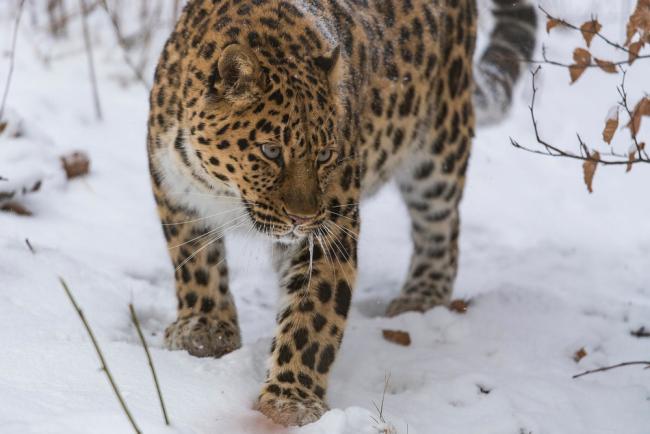
2. Amur Leopard
The Amur leopard is one of the rarest big cats in the world, with only around 100 individuals left in the wild. Although their wild population seems to be stable and increasing, these leopard subspecies are still critically endangered since 1996. And there is a good reason that: Amur leopards can only be found in a relatively small region of the far east of Russia and north-eastern China at present.
The remaining Amur leopards face multiple threats to their survival, including habitat loss and fragmentation, prey scarcity and transportation infrastructure such as roads. However, there is hope for this rare big cat. Around 75% of their home range lies in protected areas in Russia and China, and they are also moving into suitable habitats outside of these protected areas.
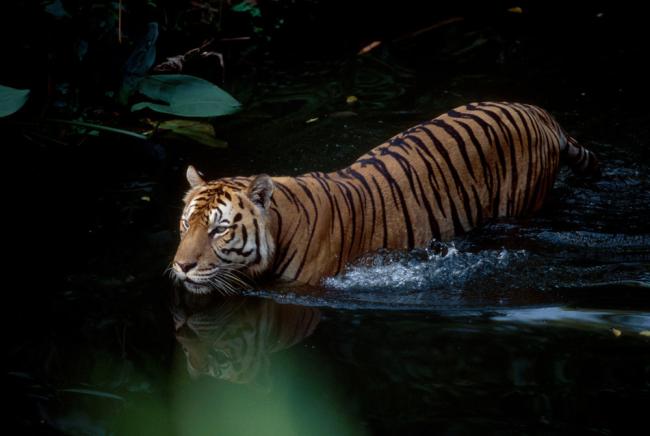
3. Sunda Island Tiger
The Sunda Island tiger, or the Sumatran tiger, is the smallest tiger subspecies in the world, weighing up to 140kg. For reference, the tigers that live in the Amur region are the biggest of all the big cats where males can weigh up to twice as much as Sunda Island tigers. They are also very rare - there are estimated to be around 600 in the wild, and are only found on the Indonesian island of Sumatra.
Since the 1980s, the human population of south-east Asia has nearly doubled from 357 million to around 668 million in 2020. And this has had an impact on tiger numbers, which have been shrinking along with their habitats.
As human settlements expand in the region, Sunda Island tigers are increasingly likely to encounter people, which could lead to a further rise in human-tiger conflict. Tiger poaching and illegal trading of tiger parts and products are also of serious concern to their survival.
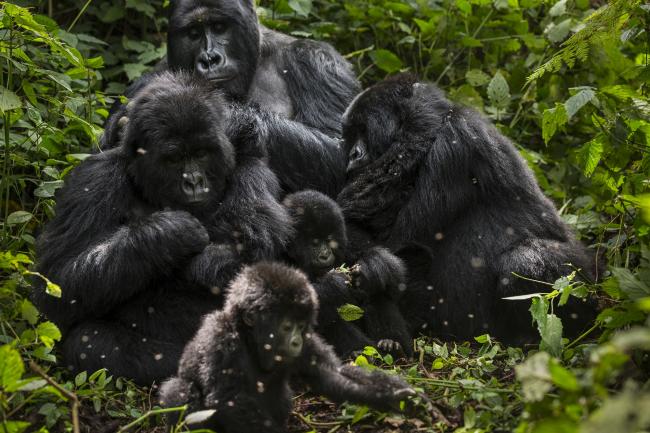
4. Mountain Gorillas
The Mountain gorilla is a subspecies of the eastern gorilla, which lives in two isolated populations in the high-altitude forests up in the volcanic, mountainous regions of the Democratic Republic of Congo, Rwanda and Uganda, and in the Bwindi Impenetrable National Park of Uganda.
The Virunga Landscape has a history of political instability along with high levels of poverty in the region. This poses a substantial threat to mountain gorilla numbers as people have moved into areas closer to these great apes for food, shelter and space—over 500,000 people live near mountain gorilla habitat at present. Despite this, mountain gorillas are making a promising recovery with conservation efforts and interventions from local and international partners and the WWF through the International Gorilla Conservation Programme.
At present, mountain gorillas are currently listed as endangered species, with just over 1,000 individuals in the wild. However, multiple threats remain that can hinder recovery progress for this species.
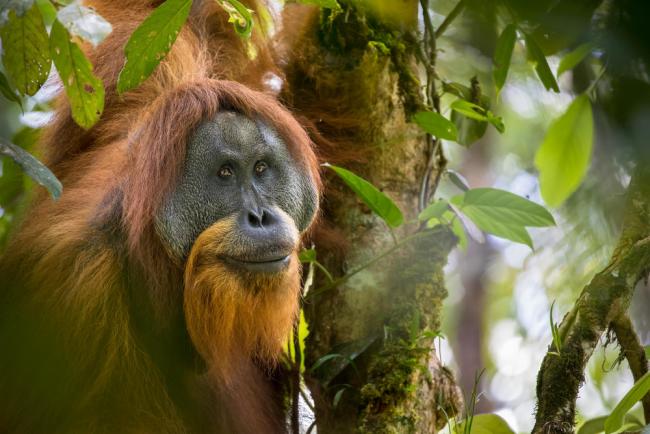
5. Tapanuli Orangutan
The Tapanuli orangutan is the newly described species of orangutan, listed as a distinct species in 2017. Only a single, isolated population of Tapanuli orangutans exist in the wild, which is restricted to the tropical forests of the Batang Toru ecosystem on the island of Sumatra, Indonesia.
Today, these tree-dwelling primates are critically endangered with fewer than 800 individuals in the wild, making them the most endangered great ape species in the world. The loss of habitat is one of the main threats to its survival as tropical forests are being replaced by agriculture, mining, and hydroelectric and geothermal development. Between 1985 and 2007, over 40% of the forests in the province of North Sumatra, where the Tapanali orangutan is found, were lost.
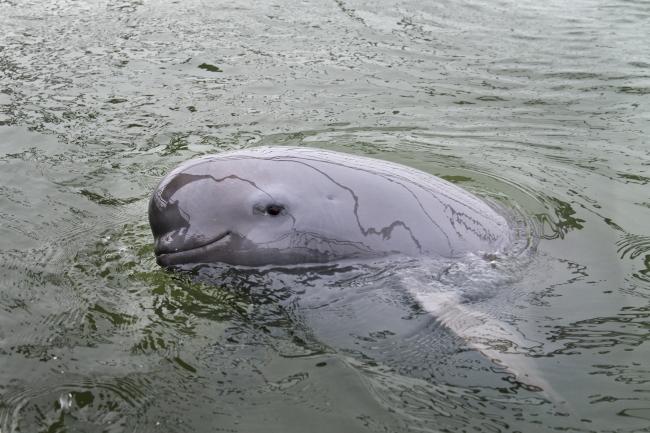
6. Yangtze Finless Porpoise
The Yangtze Finless Porpoise is the odd one out of its family as it is the only living freshwater porpoise found in the world. This aquatic mammal currently resides in the Yangtze River in China and is listed as a critically endangered species.
While the Yangtze river plays a crucial role in healthy ecosystem functioning, years of environmental degradation, overfishing and water pollution in the region are having detrimental impacts on many animal species who call it their home.
Once upon a time, Yangtze river dolphins used to live alongside finless porpoises, but there haven't been any freshwater dolphin sightings for the past two decades. Sadly, this could be yet another stark reminder of what soon may follow for many endangered species, including the Yangtze finless porpoise.
To protect this species, China has upgraded finless porpoises to ‘first level protected species’ in 2021—the highest level of protection available in the country. In 2018, their numbers were still around 1,000 individuals and stabilising in the wild.
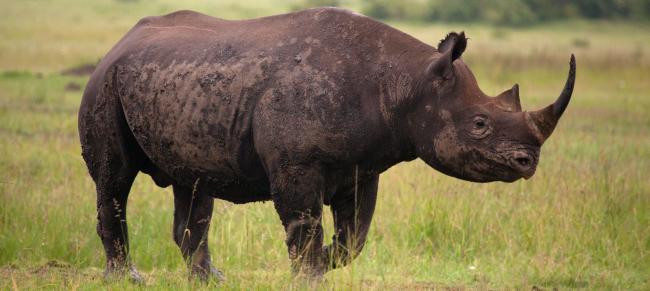
7. Black Rhinos
Between 1960 and 1995, black rhino populations suffered dramatic losses in their numbers due to large-scale poaching. Around 2% survived the severe onslaught of the past. As rhino conservation took hold, their numbers have more than doubled across Africa since the 1990s. But, black rhinos are still listed as critically endangered by the IUCN, with around 5,630 individuals in the wild.
Three subspecies of black rhino now survive, with the western black rhino declared extinct in 2011. Today, 95% of black rhinos are found in just four countries: Kenya, Namibia, South Africa and Zimbabwe. The biggest threat to the remaining population is still poaching for their horn—in the last 10 years, almost 10,000 African rhinos have been killed to supply the illegal rhino horn trade.
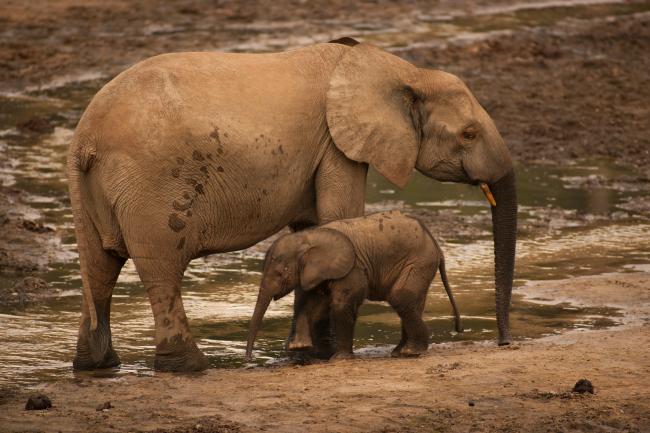
8. African Forest Elephant
Deep in the dense, humid forests of West and Central Africa, you can find the elusive forest elephant, one of the two members of the African elephant species. The actual number of wild African forest elephants remains uncertain due to their shy nature, but we do know that they are critically endangered species and have declined by an estimated 86% over 31 years.
The main reason behind the decline is due to poaching, which is frequent, widespread and intensive, especially in Central Africa. As well as elephant poaching, habitat loss and land-use change for agriculture and other land uses have resulted in fragmented habitats and increasing human-elephant conflict leading to losses on both sides.
Today, African forest elephants occupy around 25% of their historic range, scattered among 20 different African nations, mostly in Gabon and the Republic of Congo.
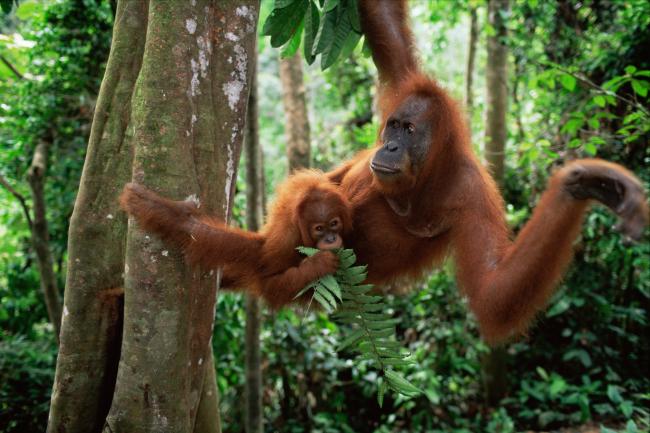
9. Sumatran Orangutan
The Sumatran orangutan is found exclusively on the island of Sumatra, Indonesia. They are listed as critically endangered by the IUCN at present, with less than 14,000 individuals in the wild.
Sumatran orangutans face similar threats to their Bornean and Tapanuli counterparts. From logging, agricultural plantations, and expanding infrastructure development to the illicit pet trade.
Orangutans need vast tracts of connecting forest to live in but between 1985 and 2007 these great apes lost 60% of their forest habitat. Today the majority of these orangutans are found in the northernmost tip of Sumatra in the Leuser Ecosystem, a landscape that includes tropical lowland rainforests and steamy peatland swamps.
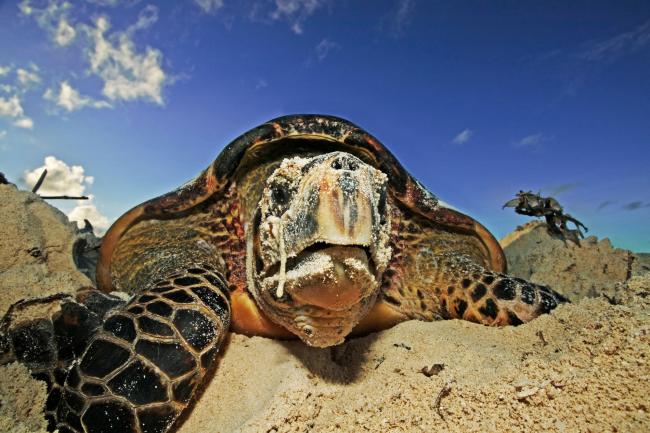
10. Hawksbill Turtles
The Hawksbill turtle is one of the seven species of marine turtles and is found in nearshore tropical and subtropical waters of the Atlantic, the Indian, and the Pacific Ocean. Their numbers are believed to be between 20,000 and 23,000 nesting turtles, although it is difficult to assess their true population numbers since marine turtles are the true ocean wanderers.
In the last 30 years, the worldwide populations of hawksbill turtles have reduced by at least 80% as a consequence of accidental capture in fishing gears, nesting habitat degradation, coral reef damage and the illegal trade of hawksbill shells and products.
Other human-led threats such as plastic pollution, climate change and rising sea levels could further contribute to the decline of this species in the future. At present, Hawksbill turtles are listed as critically endangered.
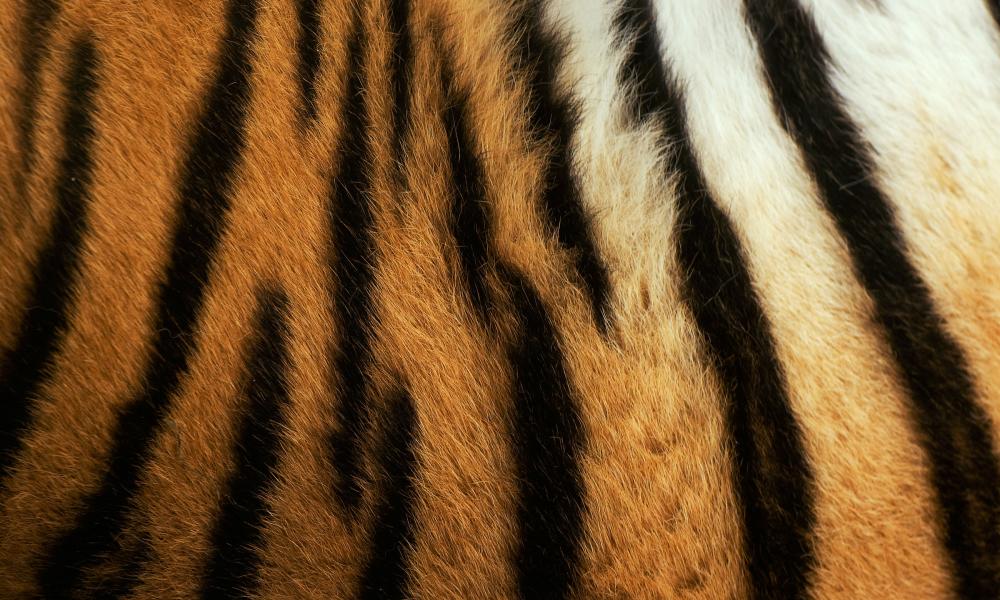
We are addressing our planet's biggest threats by understanding, promoting, and protecting wild habitats and our unique wildlife. With your help, tiger populations are recovering in Thailand, rhino numbers are increasing in Nepal, and world leaders have pledged to halt and reverse deforestation by 2030. You can help us make a difference too, by supporting our work to create a better future where people and nature can thrive.
Help us help nature
As humans continue to shape the planet, the natural world is declining. But it doesn't have to be this way. With your help, forests can be replanted, oceans can be restored, nature can be preserved, and wildlife can be protected.
If you would like to support our work, adopt an animal today and help make a difference where it really matters.

- ENVIRONMENT
One million species at risk of extinction, UN report warns
A landmark global assessment warns that the window is closing to safeguard biodiversity and a healthy planet. Yet solutions are in sight.
The bonds that hold nature together may be at risk of unraveling from deforestation, overfishing, development, and other human activities, a landmark United Nations report warns. Thanks to human pressures, one million species may be pushed to extinction in the next few years, with serious consequences for human beings as well as the rest of life on Earth.
“The evidence is crystal clear: Nature is in trouble. Therefore we are in trouble,” said Sandra Díaz, one of the co-chairs of the Global Assessment Report on Biodiversity and Ecosystem Services. A 40-page “Summary for Policy Makers” of the forthcoming full report (expected to exceed 1,500 pages) was released May 6 in Paris.
Related: Iconic Endangered Species

Based on a review of about 15,000 scientific and government sources and compiled by 145 expert authors from 50 countries, the global report is the first comprehensive look in 15 years at the state of the planet’s biodiversity. This report includes, for the first time, indigenous and local knowledge as well as scientific studies. The authors say they found overwhelming evidence that human activities are behind nature’s decline. They ranked the major drivers of species decline as land conversion, including deforestation ; overfishing ; bush meat hunting and poaching; climate change; pollution; and invasive alien species.
The tremendous variety of living species—at least 8.7 million , but possibly many more —that make up our “life-supporting safety net” provide our food, clean water, air, energy, and more, said Díaz, an ecologist at the National University of Cordoba in Argentina, in an interview. “Not only is our safety net shrinking, it’s becoming more threadbare and holes are appearing.”
A world of green slime?
In parts of the ocean, little life remains but green slime. Some remote tropical forests are nearly silent as insects have vanished , and grasslands are increasingly becoming deserts. Human activity has resulted in the severe alteration of more than 75 percent of Earth’s land areas, the Global Assessment found. And 66 percent of the oceans, which cover most of our blue planet, have suffered significant human impacts. This includes more than 400 dead zones —where scant life can survive—that collectively would cover the state of Oregon or Wyoming.
The new report paints “an ominous picture” of the health of ecosystems rapidly deteriorating, said Sir Robert Watson, Chair of the Intergovernmental Science-Policy Platform on Biodiversity and Ecosystem Services (IPBES), which conducted the global assessment. IPBES is often described as the equivalent of the Intergovernmental Panel for Climate Change for biodiversity and does scientific assessments on the status of the non-human life that makes up the Earth’s life-support system.
For Hungry Minds
“We are eroding the very foundations of our economies, livelihoods, food security, health, and quality of life worldwide,” Watson said in a statement.
“My biggest personal concern is the state of the oceans,” Watson told National Geographic. “ Plastics , dead zones, overfishing, acidification... We’re really screwing up the oceans in a big way.”
Saving more species
Protecting nature and saving species is all about securing the land and water plants and animals need to survive, said Jonathan Baillie , executive vice president and chief scientist of the National Geographic Society. Protecting half of the planet by 2050, with an interim target of 30 percent by 2030 , is the only way to meet the Paris climate targets or achieve the UN’s Sustainable Development Goals for the world, Baillie said.
Forests, oceans, and other parts of nature soak up 60 percent of global fossil fuel emissions every year, the report found. “We need to secure the biosphere to protect the climate and help buffer us from extreme weather events,” Baillie said.
Coral reefs and mangroves protect coastal areas from storms such as hurricanes. Wetlands reduce flooding by absorbing heavy rainfall. Yet each of these ecosystems has declined dramatically, with wetlands down to less than 15 percent of what they were 300 years ago and coral reefs facing a global bleaching crisis .
Nearly 100 groups around the world (including the National Geographic Society and the Wyss Campaign for Nature) have endorsed the goal of protecting half of the planet by 2050. Recently, 19 of the world’s leading scientists published a study to make a science-backed plan for an interim step that would protect 30 percent by 2030 under what’s called a Global Deal for Nature . The proposed protection does not mean “no go” areas, but rather areas protected from resource extraction and land conversion. Sustainable uses would be permitted in all but the most sensitive areas, the groups wrote.
“The international community has both the time and the tools to safeguard nature and slow the ongoing wildlife extinction crisis,” Brian O’Donnell, director of the Wyss Campaign for Nature, said in a statement.
You May Also Like

Arabian cobra becomes 12,000th animal added to ark of at-risk species

Behold the surreal magic and mystery of slime molds

14 bison came to Catalina for a movie. 100 years later, what’s next?
National Geographic Society and the Wyss Campaign for Nature are working together to inspire the protection of 30 percent of the planet by 2030 .
Such tools were under discussion during the week-long negotiations by IPBES country members who debated the key messages and policy options to be published in the “Summary for Policymakers.” The full Global Assessment report will be published later this year.
“The main message of our report is that transformative change is urgently needed. There are no other options” said David Obura, a marine biologist at the Coastal Oceans Research and Development – Indian Ocean in Mombasa, Kenya. “There’s so little time left to save corals. If we can save corals we could save everything.”
Value nature not stuff
In order to safeguard a healthy planet, society needs to shift from a sole focus on chasing economic growth, the summary report concludes. That won’t be easy, the report acknowledges. But it could get easier if countries begin to base their economies on an understanding that nature is the foundation for development. Shifting to nature-based planning can help provide a better quality of life with far less impact.
Putting that concept into practical terms, the report says countries need to reform hundreds of billions in dollars in subsidies and incentives that are currently given to the energy, fishing, agricultural, and forestry sectors. Instead of driving additional exploitation of the world’s natural resources, those monies should be shifted to incentivize protection and restoration of nature—such as underwriting new reserves or reforestation programs, the report said.
“We need to change what we value: nature, ecosystems, social equity, not growing the GDP,” Obura said.
The other evidence gathered by IPBES shows that nature managed by indigenous peoples and local communities is in generally better health than nature managed by national or corporate institutions, despite increasing pressures, said Joji Cariño, a senior policy advisor at the Forest Peoples Programme , a human rights organization.
At least a quarter of the global land area is traditionally owned, managed, used, or occupied by indigenous peoples. However, their land tenure and other rights are not always protected or recognized by all countries. Nor is their deep knowledge of the land and their values often considered in policies and decisions by governments. That needs to change, the Global Assessment noted.
“Indigenous peoples are key partners in the global transformation that’s needed,” said Cariño.
Yet countries still are slow to recognize this, she adds. As an example, she points to the Philippines. Forty years ago, indigenous people there stopped construction of dams on the Chico River because they were concerned about impacts on their land. Yet those dams are now being built by China under their trillion-dollar Belt and Road infrastructure initiative .
China has an important role to play in global discussions around biodiversity, because the country will host a major United Nations conference called the UN Convention on Biological Diversity in late 2020. Scientists hope a new, ambitious international agreement to protect the planet could happen there, akin to the Paris agreement around climate.
Assessment co-chair Díaz doesn’t yet know if a global agreement will arise as bold as protecting 30 percent by 2030. “If it were easy it would have already happened,” Diaz said.
“However, the evidence is clear: the future will be bad for us if we don’t act now. There is no future for us without nature.”
Related Topics
- BIODIVERSITY
- ENDANGERED SPECIES
- ENVIRONMENT AND CONSERVATION

In the heart of the Amazon, this pristine wilderness shows nature’s resilience

Fireflies are vanishing—but you can help protect them

The world's largest fish are vanishing without a trace
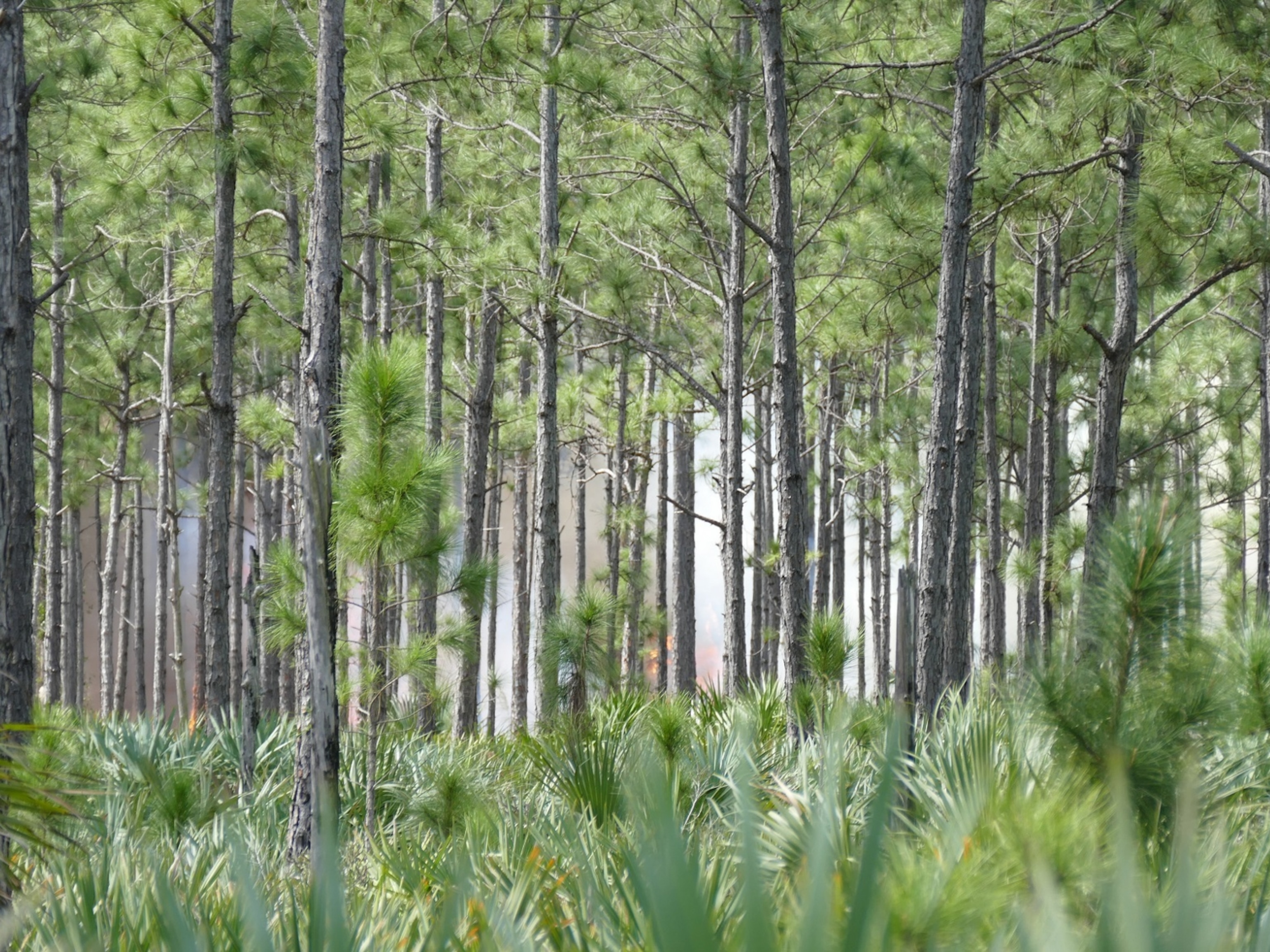
Is this paradise—or a parking lot? This Florida ecosystem is a battleground.

500 baby sharks to be released: An exclusive look at an unprecedented mission
- Paid Content
- Environment
- Photography
- Perpetual Planet
History & Culture
- History & Culture
- History Magazine
- Mind, Body, Wonder
- World Heritage
- Terms of Use
- Privacy Policy
- Your US State Privacy Rights
- Children's Online Privacy Policy
- Interest-Based Ads
- About Nielsen Measurement
- Do Not Sell or Share My Personal Information
- Nat Geo Home
- Attend a Live Event
- Book a Trip
- Inspire Your Kids
- Shop Nat Geo
- Visit the D.C. Museum
- Learn About Our Impact
- Support Our Mission
- Advertise With Us
- Customer Service
- Renew Subscription
- Manage Your Subscription
- Work at Nat Geo
- Sign Up for Our Newsletters
- Contribute to Protect the Planet
Copyright © 1996-2015 National Geographic Society Copyright © 2015-2024 National Geographic Partners, LLC. All rights reserved
Welcome Guest!
- IELTS Listening
- IELTS Reading
- IELTS Writing
- IELTS Writing Task 1
- IELTS Writing Task 2
- IELTS Speaking
- IELTS Speaking Part 1
- IELTS Speaking Part 2
- IELTS Speaking Part 3
- IELTS Practice Tests
- IELTS Listening Practice Tests
- IELTS Reading Practice Tests
- IELTS Writing Practice Tests
- IELTS Speaking Practice Tests
- All Courses
- IELTS Online Classes
- OET Online Classes
- PTE Online Classes
- CELPIP Online Classes
- Free Live Classes
- Australia PR
- Germany Job Seeker Visa
- Austria Job Seeker Visa
- Sweden Job Seeker Visa
- Study Abroad
- Student Testimonials
- Our Trainers
- IELTS Webinar
- Immigration Webinar
Animals Are in Danger of Extinction – Writing Task 2 Agree and Disagree Essay
Updated On Oct 06, 2023

Share on Whatsapp
Share on Email
Share on Linkedin
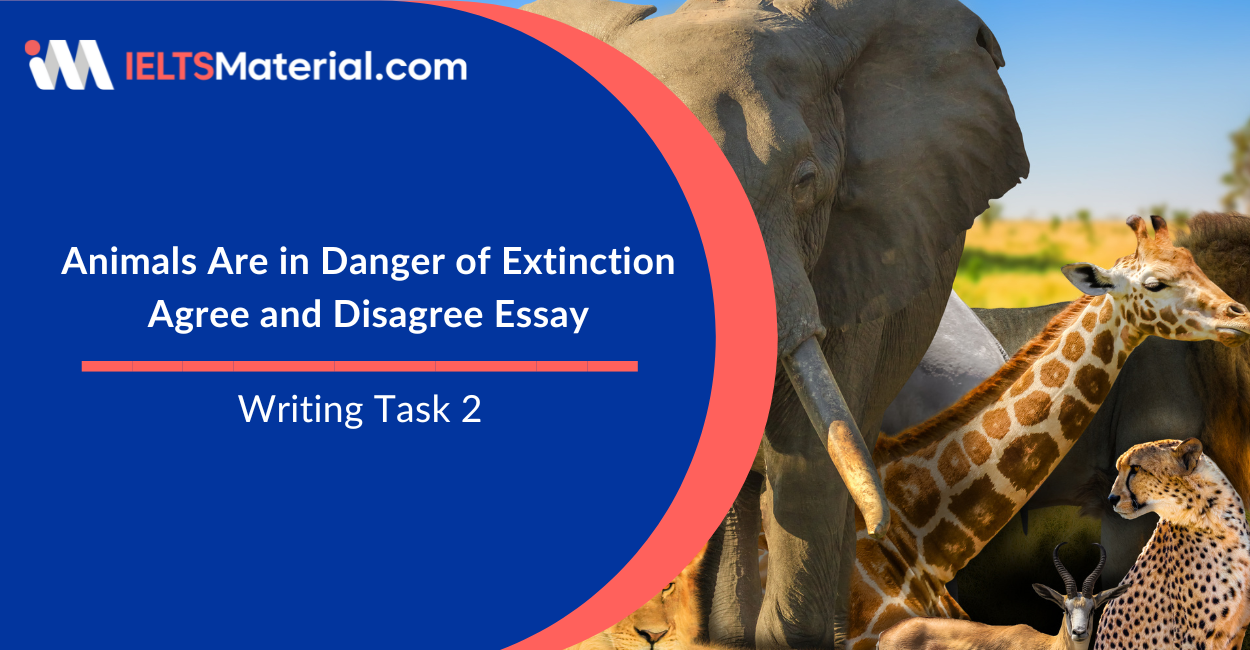
Limited-Time Offer : Access a FREE 10-Day IELTS Study Plan!
The essay writing section of the IELTS Writing Module can be a difficult task for many IELTS aspirants. Thus, it is vital that you polish your essay writing skills before attempting the IELTS.
Find below the band 8 sample answer for writing task 2 on, “Animals are in danger of extinction.” This Agree or Disagree Essay is a part of Writing Task 2 of the IELTS and is discussed here with an outline and vocabulary that will help you to prepare.
Learn some more Ways to achieve a band score of 8 for Writing Task 2 and check out the IELTS essay for Animals Are in Danger of Extinction given below.
You should spend no more than 40 minutes on this task.
Agree or Disagree Essay
Introduction
Animals are in danger of extinction, globally and it’s a serious concern for many species. While some argue that we should only save species directly benefiting humanity, I firmly disagree with this.
Paragraph 1: Human activity stands as the primary driver of the extinction crisis.
Paragraph 2: Maintaining a balanced ecosystem demands that we take collective action.
Clearly restate points covered in the essay in a summary.
Do you have an essay on this topic?
Post yours in the comment section so that, One of our expert IELTS trainers can evaluate it and reply to your comment!
Get Evaluated for FREE!
Band 8 Sample Answer for Animals Are in Danger of Extinction Writing Task 2
Animals are in danger of extinction, globally and it’s a serious concern for many species. While some argue that we should only save species directly benefiting humanity, I firmly disagree with this. Prioritizing human needs over animal welfare in safeguarding endangered species seems counterproductive and ethically flawed.
Firstly, human activity stands as the primary driver of the extinction crisis. Moreover, overpopulation, continuous urban expansion, and the relentless exploitation of natural resources have left many species struggling due to habitat loss. People’s actions are not to condone brutality and cruelty, such as encroaching on their homes, exploiting them for sustenance, or wearing their skins as fashion.
Additionally, maintaining a balanced ecosystem demands that we take collective action. Each species plays a unique role, and distancing ourselves from some non-human organisms can have devastating consequences. Focusing solely on species proportionally more useful to us disrupts the delicate food chain, leading to imbalances in animal populations. For example, protecting a predator species on the rise might lead to the sharp decline of specific herbivores, leaving the predator starved and jeopardizing the ecosystem.
In conclusion, our priority should be saving all endangered creatures, not just those benefiting us directly. Compassion, respect for life, and understanding the intricate interconnections of the ecosystem are vital. We must unite to protect animals from extinction, preserving the rich biodiversity that sustains life on Earth. Together, we as humans can start embracing a holistic approach to conservation and safeguard the delicate balance of the planet’s intricate web of life.
Aspiring to Crack the IELTS Writing?
Get expert help today with a FREE demo session! Sign up, Now!
1. Extinction
Meaning: The complete disappearance of a species from the Earth, often due to environmental changes or human activities.
Eg: Recently, some wild orchids have been threatened with extinction
2. Safeguarding
Meaning: Protecting or ensuring the safety of something, in this context, refers to the protection of endangered species.
Eg: He was accustomed to hearing and safeguarding the secrets of others.
3. Counterproductive
Meaning: Having the opposite effect of what is desired or intended, making the situation worse rather than better.
Eg: Staying up all night to study for that history test will be counterproductive – you’ll be so tired that you won’t remember any of the information you reviewed.
4. Ethically
Meaning: Relating to principles of right and wrong, particularly in terms of moral conduct and behaviour.
Eg: Millions of people are deciding to shop ethically and shop less.
5. Ecosystem
Meaning: A biological community of interacting organisms and their physical environment, where each species plays a specific role in maintaining the balance of the environment.
Eg: The marine ecosystem of the northern Gulf had suffered irreparable damage
Useful Links:
- People from prison – Agree or disagree essay
- Improve the safety of roads – Agree or disagree essay
- Using the internet in schools – Agree or disagree essay
Explore IELTS Writing

Start Preparing for IELTS: Get Your 10-Day Study Plan Today!
Nehasri Ravishenbagam
Nehasri Ravishenbagam, a Senior Content Marketing Specialist and a Certified IELTS Trainer of 3 years, crafts her writings in an engaging way with proper SEO practices. She specializes in creating a variety of content for IELTS, CELPIP, TOEFL, and certain immigration-related topics. As a student of literature, she enjoys freelancing for websites and magazines to balance her profession in marketing and her passion for creativity!
Explore other Writing Task 2 Actual Tests

Kasturika Samanta

Post your Comments
Recent articles.

Raajdeep Saha

Our Offices
Gurgaon city scape, gurgaon bptp.
Step 1 of 3
Great going .
Get a free session from trainer
Have you taken test before?
Please select any option
Get free eBook to excel in test
Please enter Email ID
Get support from an Band 9 trainer
Please enter phone number
Already Registered?
Select a date
Please select a date
Select a time (IST Time Zone)
Please select a time
Mark Your Calendar: Free Session with Expert on
Which exam are you preparing?
Great Going!
- IELTS Scores
- Life Skills Test
- Find a Test Centre
- Alternatives to IELTS
- General Training
- Academic Word List
- Topic Vocabulary
- Collocation
- Phrasal Verbs
- Writing eBooks
- Reading eBook
- All eBooks & Courses
- Sample Essays
Extinction of Animals Essay
This extinction of animals essay question appeared recently in the IELTS test.
It is about how animals become extinct and whether humans should take steps to prevent this from happening.
It is a natural process that animal species become extinct, as the dinosaurs did in the past. There is no reason for people to prevent this from happening.
To what extent do you agree or disagree?
Choosing a Side
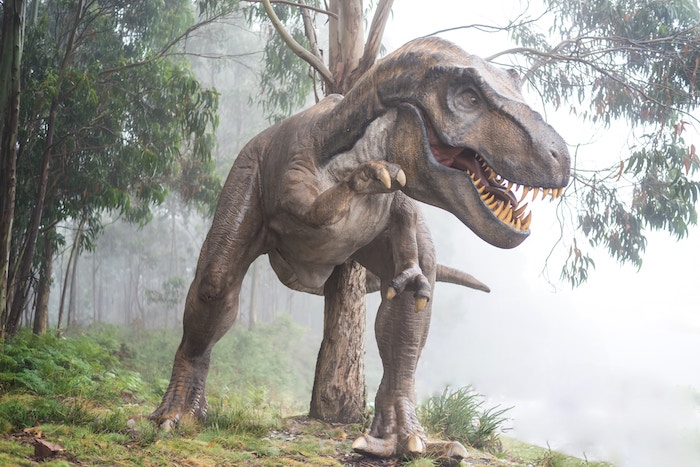
With agree / disagree type essays you can discuss both sides of the issue but you can come down firmly on one side and focus on only this in your response.
This can be an easier way to answer such questions and is certainly recommended if you are just needing the lower band scores, such as 7 and especially 6.
This is an example of an essay where the writer disagrees with the opinion and has given three reasons for this, set out in three body paragraphs.
For the higher band scores there is a risk the examiner thinks for a fully addressed answer , both sides of the issue should have been considered. So if you need a band 8 or 9, look at both sides of the issue as in this model answer.
Take a look at the model answer for this animal extinction essay and the comments below.
Extinction of Animals Essay Sample
You should spend about 40 minutes on this task.
Write about the following topic:
Give reasons for your answer and include any relevant examples from your own experience or knowledge.
Write at least 250 words.
Model Answer
It is commonly known that many species have gone extinct throughout history, including the dinosaurs. Some argue that preventing extinction is not necessary, as it is a natural process. However, I believe that humans have a moral obligation to protect endangered species and prevent their extinction.
Firstly, human activities such as deforestation, overfishing, and pollution have caused a rapid decline in animal populations, leading many species to be at risk of extinction. As a result, humans have a responsibility to conserve the environment and prevent further harm to wildlife. It is unfair for humans to cause the extinction of a species due to their actions, particularly when they have the ability to prevent it.
Another reason is that many species play a crucial role in maintaining the balance of the ecosystem. For example, bees are essential pollinators that are responsible for pollinating 80% of flowering plants, and thus if bees were to become extinct, it would have a devastating impact on our food supply and ecosystem. Similarly, the loss of predators can cause a ripple effect, leading to overpopulation of other species and causing imbalances in the food chain.
Lastly, preventing extinction is not only a matter of responsibility but also a matter of morality. Species have intrinsic value, and it is not our place to determine which species should exist and which should not. Humans must respect the inherent value of all life forms and do what they can to protect them.
In conclusion, while extinction may be a natural process, it is not a justification for humans to sit idly by and watch as countless species go extinct. By taking action to conserve the environment, humans can ensure that future generations can enjoy the same diversity of life that we have today.
(294 Words)
This extinction of animals essay would achieve a high IELTS band score.
It's organised well so would score highly for coherence and cohesion . It has a clear introduction that introduces the topics and then gives the writers opinion (the thesis statement).
Each body paragraph clearly sets out and explains a key idea, then the conclusion summarises the writers view and gives some final thoughts. The linking between sentences is also very good.
It has a clear opinion and that opinion is reflected in the response. The ideas are fully supported and explained. The question is fully addressed and the essay does not go off-topic. It would therefore score highly for task response .
The essay also had a good range of high-level and accurate lexis and grammar , so it would also score well for those criteria.
<<< Back
Next >>>
More Agree / Disagree Essays:

Paying Taxes Essay: Should people keep all the money they earn?
Paying Taxes Essay: Read model essays to help you improve your IELTS Writing Score for Task 2. In this essay you have to decide whether you agree or disagree with the opinion that everyone should be able to keep their money rather than paying money to the government.

Sample IELTS Writing: Is spending on the Arts a waste of money?
Sample IELTS Writing: A common topic in IELTS is whether you think it is a good idea for government money to be spent on the arts. i.e. the visual arts, literary and the performing arts, or whether it should be spent elsewhere, usually on other public services.

Internet vs Newspaper Essay: Which will be the best source of news?
A recent topic to write about in the IELTS exam was an Internet vs Newspaper Essay. The question was: Although more and more people read news on the internet, newspapers will remain the most important source of news. To what extent do you agree or disagree?

Examinations Essay: Formal Examinations or Continual Assessment?
Examinations Essay: This IELTS model essay deals with the issue of whether it is better to have formal examinations to assess student’s performance or continual assessment during term time such as course work and projects.

Technology Development Essay: Are earlier developments the best?
This technology development essay shows you a complex IELTS essay question that is easily misunderstood. There are tips on how to approach IELTS essay questions

IELTS Vegetarianism Essay: Should we all be vegetarian to be healthy?
Vegetarianism Essay for IELTS: In this vegetarianism essay, the candidate disagrees with the statement, and is thus arguing that everyone does not need to be a vegetarian.

Return of Historical Objects and Artefacts Essay
This essay discusses the topic of returning historical objects and artefacts to their country of origin. It's an agree/disagree type IELTS question.

Airline Tax Essay: Would taxing air travel reduce pollution?
Airline Tax Essay for IELTS. Practice an agree and disagree essay on the topic of taxing airlines to reduce low-cost air traffic. You are asked to decide if you agree or disagree with taxing airlines in order to reduce the problems caused.

Multinational Organisations and Culture Essay
Multinational Organisations and Culture Essay: Improve you score for IELTS Essay writing by studying model essays. This Essay is about the extent to which working for a multinational organisation help you to understand other cultures.

Truthfulness in Relationships Essay: How important is it?
This truthfulness in relationships essay for IELTS is an agree / disagree type essay. You need to decide if it's the most important factor.

IELTS Sample Essay: Is alternative medicine ineffective & dangerous?
IELTS sample essay about alternative and conventional medicine - this shows you how to present a well-balanced argument. When you are asked whether you agree (or disagree), you can look at both sides of the argument if you want.

Human Cloning Essay: Should we be scared of cloning humans?
Human cloning essay - this is on the topic of cloning humans to use their body parts. You are asked if you agree with human cloning to use their body parts, and what reservations (concerns) you have.

Role of Schools Essay: How should schools help children develop?
This role of schools essay for IELTS is an agree disagree type essay where you have to discuss how schools should help children to develop.

Ban Smoking in Public Places Essay: Should the government ban it?
Ban smoking in public places essay: The sample answer shows you how you can present the opposing argument first, that is not your opinion, and then present your opinion in the following paragraph.

Dying Languages Essay: Is a world with fewer languages a good thing?
Dying languages essays have appeared in IELTS on several occasions, an issue related to the spread of globalisation. Check out a sample question and model answer.

Essay for IELTS: Are some advertising methods unethical?
This is an agree / disagree type question. Your options are: 1. Agree 100% 2. Disagree 100% 3. Partly agree. In the answer below, the writer agrees 100% with the opinion. There is an analysis of the answer.

IELTS Internet Essay: Is the internet damaging social interaction?
Internet Essay for IELTS on the topic of the Internet and social interaction. Included is a model answer. The IELTS test usually focuses on topical issues. You have to discuss if you think that the Internet is damaging social interaction.

Employing Older People Essay: Is the modern workplace suitable?
Employing Older People Essay. Examine model essays for IELTS Task 2 to improve your score. This essay tackles the issue of whether it it better for employers to hire younger staff rather than those who are older.

Free University Education Essay: Should it be paid for or free?
Free university education Model IELTS essay. Learn how to write high-scoring IELTS essays. The issue of free university education is an essay topic that comes up in the IELTS test. This essay therefore provides you with some of the key arguments about this topic.

Scientific Research Essay: Who should be responsible for its funding?
Scientific research essay model answer for Task 2 of the test. For this essay, you need to discuss whether the funding and controlling of scientific research should be the responsibility of the government or private organizations.
Any comments or questions about this page or about IELTS? Post them here. Your email will not be published or shared.
Before you go...
Check out the ielts buddy band 7+ ebooks & courses.

Would you prefer to share this page with others by linking to it?
- Click on the HTML link code below.
- Copy and paste it, adding a note of your own, into your blog, a Web page, forums, a blog comment, your Facebook account, or anywhere that someone would find this page valuable.
Band 7+ eBooks
"I think these eBooks are FANTASTIC!!! I know that's not academic language, but it's the truth!"
Linda, from Italy, Scored Band 7.5

IELTS Modules:
Other resources:.
- All Lessons
- Band Score Calculator
- Writing Feedback
- Speaking Feedback
- Teacher Resources
- Free Downloads
- Recent Essay Exam Questions
- Books for IELTS Prep
- Useful Links

Recent Articles
Key Phrases for IELTS Speaking: Fluency and Coherence
May 26, 24 06:52 AM
Useful Language for IELTS Graphs
May 16, 24 04:44 AM

Taking a Gap Year
May 14, 24 03:00 PM
Important pages
IELTS Writing IELTS Speaking IELTS Listening IELTS Reading All Lessons Vocabulary Academic Task 1 Academic Task 2 Practice Tests
Connect with us
Copyright © 2022- IELTSbuddy All Rights Reserved
IELTS is a registered trademark of University of Cambridge, the British Council, and IDP Education Australia. This site and its owners are not affiliated, approved or endorsed by the University of Cambridge ESOL, the British Council, and IDP Education Australia.

Press ESC to close

Animals are in Danger of Extinction IELTS: Best IELTS Writing Preparation from IELTS Ninja
The IELTS writing task appears challenging since everything is based on your level and way of thinking; your language, vocabulary and grammar are thoroughly examined, and precision is rated.
Many people believe this test is straightforward, but when it comes to writing, they reconsider because no one can write adequately according to this test’s degree. Continue reading for some responses to today’s writing prompt: Animals are threatened with extinction. Read the article below to know more about writing task preparation.
Also Read: How To Prepare For IELTS in 10 Days: A Super Strategy To Achieve Your Desired Band Score
Animals are in Danger of Extinction IELTS
The extinction of animals has become a major problem. I disagree with the statement that only those animals that are beneficial to humans should be conserved. All animals, I believe, have a direct or indirect impact on humanity. Measures to protect wildlife have been correctly stated as plans to safeguard man. They should converse for their good and people should know the importance of animals.

IELTS Exam Preparation: IELTS Writing Task
Ielts essay: paragraph 1.
Another factor that contributes to environmental change is pollution. Many bird species around the world, such as the bald eagle, pelicans, peregrine hawk, and roseate terns, have thin shells as a result of low-quality foods and other chlorinated hydrocarbon pesticides that find their way into the food chain.
Salamander species are vanishing in New England because acid rain has contaminated the ponds where they reproduce and the damp soil where they must reside.
Humans damage the natural habitats of animals and plants for land development and agriculture. Animal poaching and hunting for meat, fur, jewellery, and leather are also significant contributors to wildlife extinction. If no immediate action is made to rescue the fauna, it will not be long before they are added to the list of extinct species.
Also Read: The Key to Solving The Environmental Problem: Check Out The Sample Answers to This Topic
IELTS Essay: Paragraph 2
And that’s not the end of it! The extinction of wild species will almost definitely be disastrous to humanity. As a result, it falls to us as human beings to conserve the species, our planet, and, most importantly, ourselves. Here are a few more reasons why wildlife is so vital for sustaining ecological equilibrium.
If the quantity of birds and insects carrying pollen reduces for any cause, crop growth might be severely hampered. You might be astonished to learn that bee pollination is responsible for 90% of global apple production.
The ecosystem is fully dependent on the interactions of many organisms, which are linked via food webs and food chains. Even the extinction of a single wild species can disrupt the entire food chain, resulting in severe consequences. Consider the basic example of a bee, which is necessary for the growth of particular crops due to its pollen transport functions. Due to a lack of pollination, the growth of food crops would suffer if bees were to go extinct.
To summarise, it is well justified to save all of the animal species on the verge of extinction. Humans have a direct or indirect relationship with all animals. As a result, we should not focus our efforts solely on the few species that have a noticeable impact on humans.
The most important aspect to comprehend and understand is the marking criteria because if you are completely familiar with this area and scoring, you will be able to react effectively. You will have completed 25% of your work if you understand the criteria on which you will be judged. All that is left for you to do now is focus on improving those areas.
As a result, to provide the best responses to the question paper, you need to pay close attention to the marking criteria. You can appropriately prepare for each part by using grading criteria.
Visit IELTS Ninja for additional writing themes.
Also Read: IELTS Essay Questions for 2022: Top IELTS Writing Topics for Preparation

Leave a Reply Cancel reply

Share Article:

About the Author
Shilpa is a professional web content writer and is in deep love with travelling. She completed her mass communication degree and is now dedicatedly playing with words to guide her readers to get the best for themselves. Developing educational content for UPSC, IELTS aspirants from breakthrough research work is her forte. Strongly driven by her zodiac sign Sagittarius, Shilpa loves to live her life on her own notes and completely agrees with the idea of ‘live and let live. Apart from writing and travelling, most of the time she can be seen in the avatar of 'hooman' mom to her pets and street dogs or else you can also catch her wearing the toque blanche and creating magic in the kitchen on weekends.
You might also like

How to Write an Informal Letter for IELTS? Let’s Get the Best Way to Write an Informal Letter!

How to Write a Formal Letter for IELTS? Let’s Check Out the IELTS Formal Letter Writing!

Some Scientists Think That There are Intelligent Life Forms on Other Planet: Let’s Check Out the IELTS Writing Answer
Other stories, history of bicycle reading answers: let’s prepare for the ielts reading answers, power from the earth ielts reading answers: ielts academic and general reading preparation.
Thank you for visiting nature.com. You are using a browser version with limited support for CSS. To obtain the best experience, we recommend you use a more up to date browser (or turn off compatibility mode in Internet Explorer). In the meantime, to ensure continued support, we are displaying the site without styles and JavaScript.
- View all journals
- Explore content
- About the journal
- Publish with us
- Sign up for alerts
- 06 May 2019
- Update 06 May 2019
Humans are driving one million species to extinction
- Jeff Tollefson
You can also search for this author in PubMed Google Scholar
Up to one million plant and animal species face extinction, many within decades, because of human activities, says the most comprehensive report yet on the state of global ecosystems.
Access options
Access Nature and 54 other Nature Portfolio journals
Get Nature+, our best-value online-access subscription
24,99 € / 30 days
cancel any time
Subscribe to this journal
Receive 51 print issues and online access
185,98 € per year
only 3,65 € per issue
Rent or buy this article
Prices vary by article type
Prices may be subject to local taxes which are calculated during checkout
Nature 569 , 171 (2019)
doi: https://doi.org/10.1038/d41586-019-01448-4
Updates & Corrections
Update 06 May 2019 : This story has been updated with comment from Anne Larigauderie, IPBES executive secretary.
Reprints and permissions
Related Articles
The battle for the soul of biodiversity
Top UN panel paints bleak picture of world’s ecosystems
Global biodiversity report warns pollinators are under threat
- Biodiversity
- Environmental sciences

China's Yangtze fish-rescue plan is a failure, study says
News 20 MAY 24

Forestry social science is failing the needs of the people who need it most
Editorial 15 MAY 24

The rise of baobab trees in Madagascar
Article 15 MAY 24

Guidelines for academics aim to lessen ethical pitfalls in generative-AI use
Nature Index 22 MAY 24

Why the European Space Agency should join the US mission to Uranus
Comment 20 MAY 24

One-third of Southern Ocean productivity is supported by dust deposition

Diana Wall obituary: ecologist who foresaw the importance of soil biodiversity
Obituary 10 MAY 24
Sir Run Run Shaw Hospital, School of Medicine, Zhejiang University, Warmly Welcomes Talents Abroad
“Qiushi” Distinguished Scholar, Zhejiang University, including Professor and Physician
No. 3, Qingchun East Road, Hangzhou, Zhejiang (CN)
Sir Run Run Shaw Hospital Affiliated with Zhejiang University School of Medicine
Associate Editor, Nature Briefing
Associate Editor, Nature Briefing Permanent, full time Location: London, UK Closing date: 10th June 2024 Nature, the world’s most authoritative s...
London (Central), London (Greater) (GB)
Springer Nature Ltd
Professor, Division Director, Translational and Clinical Pharmacology
Cincinnati Children’s seeks a director of the Division of Translational and Clinical Pharmacology.
Cincinnati, Ohio
Cincinnati Children's Hospital & Medical Center
Data Analyst for Gene Regulation as an Academic Functional Specialist
The Rheinische Friedrich-Wilhelms-Universität Bonn is an international research university with a broad spectrum of subjects. With 200 years of his...
53113, Bonn (DE)
Rheinische Friedrich-Wilhelms-Universität
Recruitment of Global Talent at the Institute of Zoology, Chinese Academy of Sciences (IOZ, CAS)
The Institute of Zoology (IOZ), Chinese Academy of Sciences (CAS), is seeking global talents around the world.
Beijing, China
Institute of Zoology, Chinese Academy of Sciences (IOZ, CAS)
Sign up for the Nature Briefing newsletter — what matters in science, free to your inbox daily.
Quick links
- Explore articles by subject
- Guide to authors
- Editorial policies
November 1, 2023
20 min read
Can We Save Every Species from Extinction?
The Endangered Species Act requires that every U.S. plant and animal be saved from extinction, but after 50 years, we have to do much more to prevent a biodiversity crisis
By Robert Kunzig
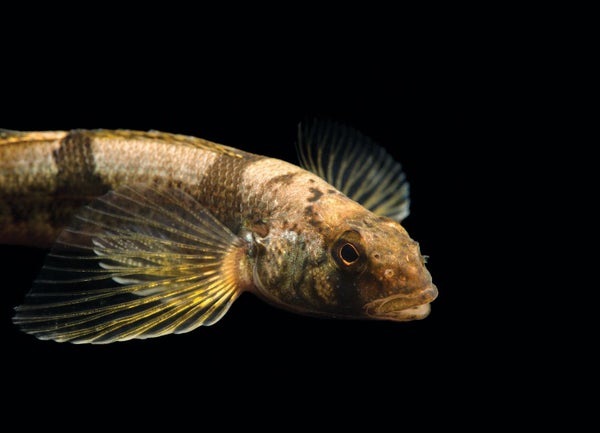
Snail Darter Percina tanasi. Listed as Endangered: 1975. Status: Delisted in 2022.
© Joel Sartore/National Geographic Photo Ark
A Bald Eagle disappeared into the trees on the far bank of the Tennessee River just as the two researchers at the bow of our modest motorboat began hauling in the trawl net. Eagles have rebounded so well that it's unusual not to see one here these days, Warren Stiles of the U.S. Fish and Wildlife Service told me as the net got closer. On an almost cloudless spring morning in the 50th year of the Endangered Species Act, only a third of a mile downstream from the Tennessee Valley Authority's big Nickajack Dam, we were searching for one of the ESA's more notorious beneficiaries: the Snail Darter. A few months earlier Stiles and the FWS had decided that, like the Bald Eagle, the little fish no longer belonged on the ESA's endangered species list. We were hoping to catch the first nonendangered specimen.
Dave Matthews, a TVA biologist, helped Stiles empty the trawl. Bits of wood and rock spilled onto the deck, along with a Common Logperch maybe six inches long. So did an even smaller fish; a hair over two inches, it had alternating vertical bands of dark and light brown, each flecked with the other color, a pattern that would have made it hard to see against the gravelly river bottom. It was a Snail Darter in its second year, Matthews said, not yet full-grown.
Everybody loves a Bald Eagle. There is much less consensus about the Snail Darter. Yet it epitomizes the main controversy still swirling around the ESA, signed into law on December 28, 1973, by President Richard Nixon: Can we save all the obscure species of this world, and should we even try, if they get in the way of human imperatives? The TVA didn't think so in the 1970s, when the plight of the Snail Darter—an early entry on the endangered species list—temporarily stopped the agency from completing a huge dam. When the U.S. attorney general argued the TVA's case before the Supreme Court with the aim of sidestepping the law, he waved a jar that held a dead, preserved Snail Darter in front of the nine judges in black robes, seeking to convey its insignificance.
On supporting science journalism
If you're enjoying this article, consider supporting our award-winning journalism by subscribing . By purchasing a subscription you are helping to ensure the future of impactful stories about the discoveries and ideas shaping our world today.
Now I was looking at a living specimen. It darted around the bottom of a white bucket, bonking its nose against the side and delicately fluttering the translucent fins that swept back toward its tail.
“It's kind of cute,” I said.
Matthews laughed and slapped me on the shoulder. “I like this guy!” he said. “Most people are like, ‘Really? That's it?’ ” He took a picture of the fish and clipped a sliver off its tail fin for DNA analysis but left it otherwise unharmed. Then he had me pour it back into the river. The next trawl, a few miles downstream, brought up seven more specimens.
In the late 1970s the Snail Darter seemed confined to a single stretch of a single tributary of the Tennessee River, the Little Tennessee, and to be doomed by the TVA's ill-considered Tellico Dam, which was being built on the tributary. The first step on its twisting path to recovery came in 1978, when the U.S. Supreme Court ruled, surprisingly, that the ESA gave the darter priority even over an almost finished dam. “It was when the government stood up and said, ‘Every species matters, and we meant it when we said we're going to protect every species under the Endangered Species Act,’” says Tierra Curry, a senior scientist at the Center for Biological Diversity.
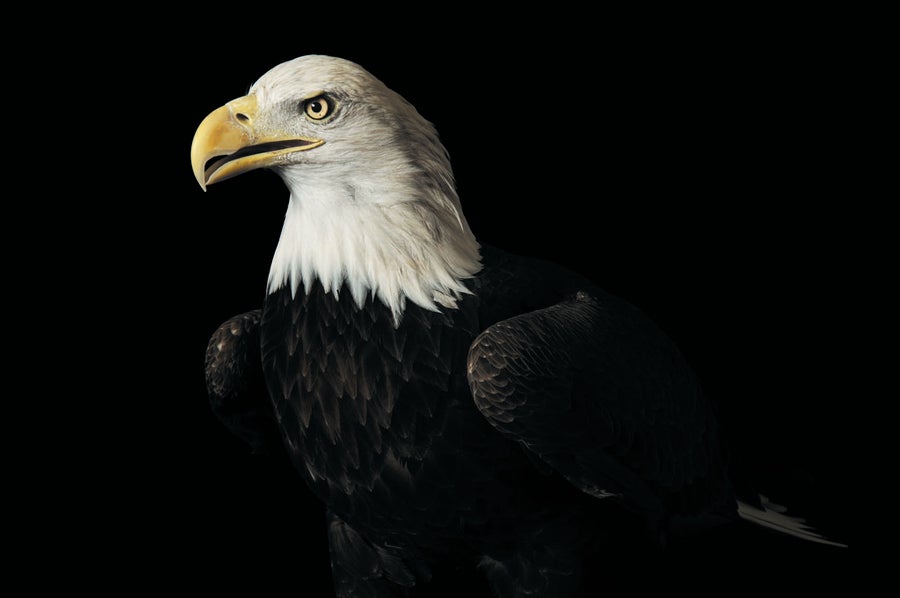
Bald Eagle Haliaeetus leucocephalus. Listed as Endangered: 1967. Status: Delisted in 2007. Credit: © Joel Sartore/National Geographic Photo Ark
Today the Snail Darter can be found along 400 miles of the river's main stem and multiple tributaries. ESA enforcement has saved dozens of other species from extinction. Bald Eagles, American Alligators and Peregrine Falcons are just a few of the roughly 60 species that had recovered enough to be “delisted” by late 2023.
And yet the U.S., like the planet as a whole, faces a growing biodiversity crisis. Less than 6 percent of the animals and plants ever placed on the list have been delisted; many of the rest have made scant progress toward recovery. What's more, the list is far from complete: roughly a third of all vertebrates and vascular plants in the U.S. are vulnerable to extinction, says Bruce Stein, chief scientist at the National Wildlife Federation. Populations are falling even for species that aren't yet in danger. “There are a third fewer birds flying around now than in the 1970s,” Stein says. We're much less likely to see a White-throated Sparrow or a Red-winged Blackbird, for example, even though neither species is yet endangered.
The U.S. is far emptier of wildlife sights and sounds than it was 50 years ago, primarily because habitat—forests, grasslands, rivers—has been relentlessly appropriated for human purposes. The ESA was never designed to stop that trend, any more than it is equipped to deal with the next massive threat to wildlife: climate change. Nevertheless, its many proponents say, it is a powerful, foresightful law that we could implement more wisely and effectively, perhaps especially to foster stewardship among private landowners. And modest new measures, such as the Recovering America's Wildlife Act—a bill with bipartisan support—could further protect flora and fauna.
That is, if special interests don't flout the law. After the 1978 Supreme Court decision, Congress passed a special exemption to the ESA allowing the TVA to complete the Tellico Dam. The Snail Darter managed to survive because the TVA transplanted some of the fish from the Little Tennessee, because remnant populations turned up elsewhere in the Tennessee Valley, and because local rivers and streams slowly became less polluted following the 1972 Clean Water Act, which helped fish rebound.
Under pressure from people enforcing the ESA, the TVA also changed the way it managed its dams throughout the valley. It started aerating the depths of its reservoirs, in some places by injecting oxygen. It began releasing water from the dams more regularly to maintain a minimum flow that sweeps silt off the river bottom, exposing the clean gravel that Snail Darters need to lay their eggs and feed on snails. The river system “is acting more like a real river,” Matthews says. Basically, the TVA started considering the needs of wildlife, which is really what the ESA requires. “The Endangered Species Act works,” Matthews says. “With just a little bit of help, [wildlife] can recover.”
The trouble is that many animals and plants aren't getting that help—because government resources are too limited, because private landowners are alienated by the ESA instead of engaged with it, and because as a nation the U.S. has never fully committed to the ESA's essence. Instead, for half a century, the law has been one more thing that polarizes people's thinking.
I t may seem impossible today to imagine the political consensus that prevailed on environmental matters in 1973. The U.S. Senate approved the ESA unanimously, and the House passed it by a vote of 390 to 12. “Some people have referred to it as almost a statement of religion coming out of the Congress,” says Gary Frazer, who as assistant director for ecological services at the FWS has been overseeing the act's implementation for nearly 25 years.
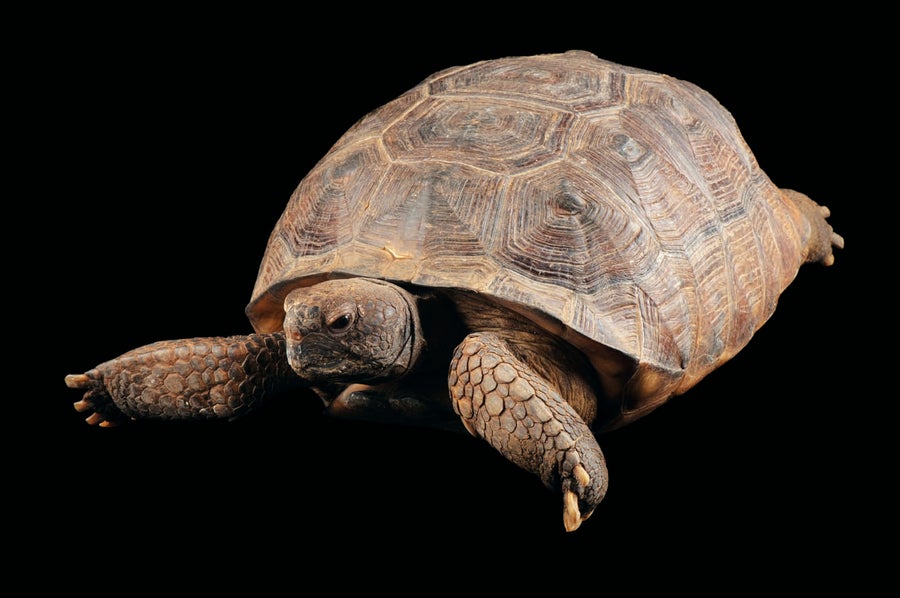
Gopher Tortoise Gopherus polyphemus . Listed as Threatened: 1987. Status: Still threatened. Credit: ©Joel Sartore/National Geographic Photo Ark
But loss of faith began five years later with the Snail Darter case. Congresspeople who had been thinking of eagles, bears and Whooping Cranes when they passed the ESA, and had not fully appreciated the reach of the sweeping language they had approved, were disabused by the Supreme Court. It found that the legislation had created, “wisely or not ... an absolute duty to preserve all endangered species,” Chief Justice Warren E. Burger said after the Snail Darter case concluded. Even a recently discovered tiny fish had to be saved, “whatever the cost,” he wrote in the decision.
Was that wise? For both environmentalists such as Curry and many nonenvironmentalists, the answer has always been absolutely. The ESA “is the basic Bill of Rights for species other than ourselves,” says National Geographic photographer Joel Sartore, who is building a “photo ark” of every animal visible to the naked eye as a record against extinction. (He has taken studio portraits of 15,000 species so far.) But to critics, the Snail Darter decision always defied common sense. They thought it was “crazy,” says Michael Bean, a leading ESA expert, now retired from the Environmental Defense Fund. “That dichotomy of view has remained with us for the past 45 years.”
According to veteran Washington, D.C., environmental attorney Lowell E. Baier, author of a new history called The Codex of the Endangered Species Act, both the act itself and its early implementation reflected a top-down, federal “command-and-control mentality” that still breeds resentment. FWS field agents in the early days often saw themselves as combat biologists enforcing the act's prohibitions. After the Northern Spotted Owl's listing got tangled up in a bitter 1990s conflict over logging of old-growth forests in the Pacific Northwest, the FWS became more flexible in working out arrangements. “But the dark mythology of the first 20 years continues in the minds of much of America,” Baier says.
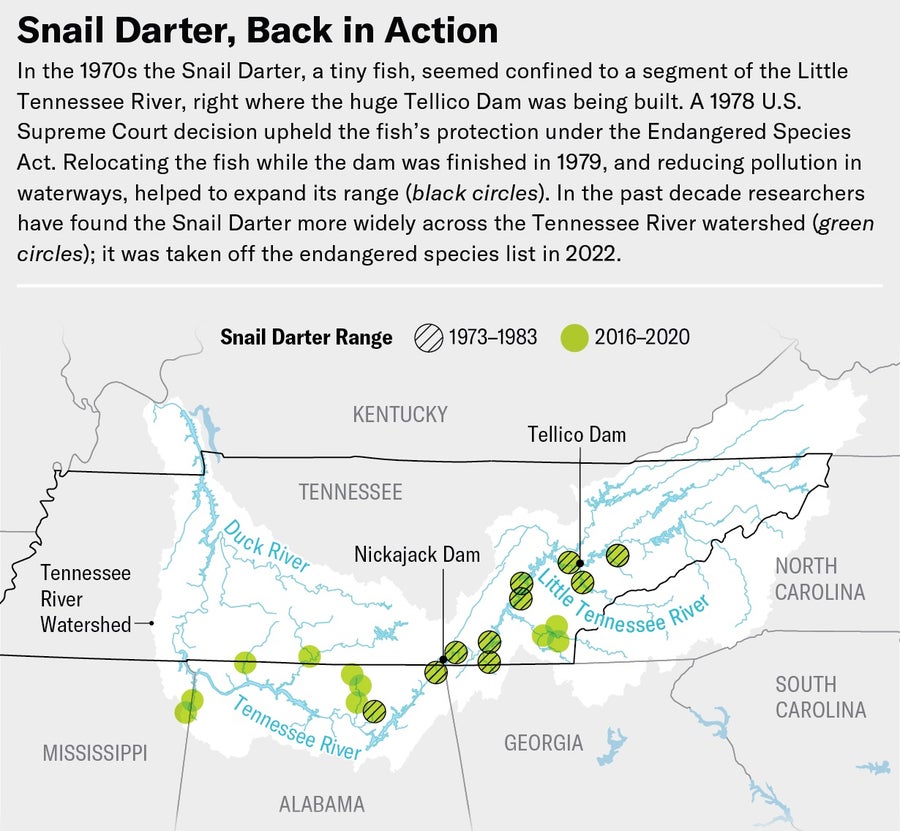
Credit: June Minju Kim ( map ); Source: David Matthews, Tennessee Valley Authority ( reference )
The law can impose real burdens on landowners. Before doing anything that might “harass” or “harm” an endangered species, including modifying its habitat, they need to get a permit from the FWS and present a “habitat conservation plan.” Prosecutions aren't common, because evidence can be elusive, but what Bean calls “the cloud of uncertainty” surrounding what landowners can and cannot do can be distressing.
Requirements the ESA places on federal agencies such as the Forest Service and the Bureau of Land Management—or on the TVA—can have large economic impacts. Section 7 of the act prohibits agencies from taking, permitting or funding any action that is likely to “jeopardize the continued existence” of a listed species. If jeopardy seems possible, the agency must consult with the FWS first (or the National Marine Fisheries Service for marine species) and seek alternative plans.
“When people talk about how the ESA stops projects, they've been talking about section 7,” says conservation biologist Jacob Malcom. The Northern Spotted Owl is a strong example: an economic analysis suggests the logging restrictions eliminated thousands of timber-industry jobs, fueling conservative arguments that the ESA harms humans and economic growth.
In recent decades, however, that view has been based “on anecdote, not evidence,” Malcom claims. At Defenders of Wildlife, where he worked until 2022 (he's now at the U.S. Department of the Interior), he and his colleagues analyzed 88,290 consultations between the FWS and other agencies from 2008 to 2015. “Zero projects were stopped,” Malcom says. His group also found that federal agencies were only rarely taking the active measures to recover a species that section 7 requires—like what the TVA did for the Snail Darter. For many listed species, the FWS does not even have recovery plans.
Endangered species also might not recover because “most species are not receiving protection until they have reached dangerously low population sizes,” according to a 2022 study by Erich K. Eberhard of Columbia University and his colleagues. Most listings occur only after the FWS has been petitioned or sued by an environmental group—often the Center for Biological Diversity, which claims credit for 742 listings. Years may go by between petition and listing, during which time the species' population dwindles. Noah Greenwald, the center's endangered species director, thinks the FWS avoids listings to avoid controversy—that it has internalized opposition to the ESA.
He and other experts also say that work regarding endangered species is drastically underfunded. As more species are listed, the funding per species declines. “Congress hasn't come to grips with the biodiversity crisis,” says Baier, who lobbies lawmakers regularly. “When you talk to them about biodiversity, their eyes glaze over.” Just this year federal lawmakers enacted a special provision exempting the Mountain Valley Pipeline from the ESA and other challenges, much as Congress had exempted the Tellico Dam. Environmentalists say the gas pipeline, running from West Virginia to Virginia, threatens the Candy Darter, a colorful small fish. The Inflation Reduction Act of 2022 provided a rare bit of good news: it granted the FWS $62.5 million to hire more biologists to prepare recovery plans.
The ESA is often likened to an emergency room for species: overcrowded and understaffed, it has somehow managed to keep patients alive, but it doesn't do much more. The law contains no mandate to restore ecosystems to health even though it recognizes such work as essential for thriving wildlife. “Its goal is to make things better, but its tools are designed to keep things from getting worse,” Bean says. Its ability to do even that will be severely tested in coming decades by threats it was never designed to confront.
T he ESA requires a species to be listed as “threatened” if it might be in danger of extinction in the “foreseeable future.” The foreseeable future will be warmer. Rising average temperatures are a problem, but higher heat extremes are a bigger threat, according to a 2020 study.
Scientists have named climate change as the main cause of only a few extinctions worldwide. But experts expect that number to surge. Climate change has been “a factor in almost every species we've listed in at least the past 15 years,” Frazer says. Yet scientists struggle to forecast whether individual species can “persist in place or shift in space”—as Stein and his co-authors put it in a recent paper—or will be unable to adapt at all and will go extinct. On June 30 the FWS issued a new rule that will make it easier to move species outside their historical range—a practice it once forbade except in extreme circumstances.

Credit: June Minju Kim ( graphic ); Brown Bird Design ( illustrations ); Sources: U.S. Fish & Wildlife Service Environmental Conservation Online System; U.S. Federal Endangered and Threatened Species by Calendar Year https://ecos.fws.gov/ecp/report/species-listings-by-year-totals ( annual data through 2022 ); Listed Species Summary (Boxscore) https://ecos.fws.gov/ecp/report/boxscore ( cumulative data up to September 18, 2023, and annual data for coral ); Delisted Species https://ecos.fws.gov/ecp/report/species-delisted ( delisted data through 2022 )
Eventually, though, “climate change is going to swamp the ESA,” says J. B. Ruhl, a law professor at Vanderbilt University, who has been writing about the problem for decades. “As more and more species are threatened, I don't know what the agency does with that.” To offer a practical answer, in a 2008 paper he urged the FWS to aggressively identify the species most at risk and not waste resources on ones that seem sure to expire.
Yet when I asked Frazer which urgent issues were commanding his attention right now, his first thought wasn't climate; it was renewable energy. “Renewable energy is going to leave a big footprint on the planet and on our country,” he says, some of it threatening plants and animals if not implemented well. “The Inflation Reduction Act is going to lead to an explosion of more wind and solar across the landscape.
Long before President Joe Biden signed that landmark law, conflicts were proliferating: Desert Tortoise versus solar farms in the Mojave Desert, Golden Eagles versus wind farms in Wyoming, Tiehm's Buckwheat (a little desert flower) versus lithium mining in Nevada. The mine case is a close parallel to that of Snail Darters versus the Tellico Dam. The flower, listed as endangered just last year, grows on only a few acres of mountainside in western Nevada, right where a mining company wants to extract lithium. The Center for Biological Diversity has led the fight to save it. Elsewhere in Nevada people have used the ESA to stop, for the moment, a proposed geothermal plant that might threaten the two-inch Dixie Valley Toad, discovered in 2017 and also declared endangered last year.
Does an absolute duty to preserve all endangered species make sense in such places? In a recent essay entitled “A Time for Triage,” Columbia law professor Michael Gerrard argues that “the environmental community has trade-off denial. We don't recognize that it's too late to preserve everything we consider precious.” In his view, given the urgency of building the infrastructure to fight climate change, we need to be willing to let a species go after we've done our best to save it. Environmental lawyers adept at challenging fossil-fuel projects, using the ESA and other statutes, should consider holding their fire against renewable installations. “Just because you have bullets doesn't mean you shoot them in every direction,” Gerrard says. “You pick your targets.” In the long run, he and others argue, climate change poses a bigger threat to wildlife than wind turbines and solar farms do.
For now habitat loss remains the overwhelming threat. What's truly needed to preserve the U.S.'s wondrous biodiversity, both Stein and Ruhl say, is a national network of conserved ecosystems. That won't be built with our present politics. But two more practical initiatives might help.
The first is the Recovering America's Wildlife Act, which narrowly missed passage in 2022 and has been reintroduced this year. It builds on the success of the 1937 Pittman-Robertson Act, which funds state wildlife agencies through a federal excise tax on guns and ammunition. That law was adopted to address a decline in game species that had hunters alarmed. The state refuges and other programs it funded are why deer, ducks and Wild Turkeys are no longer scarce.
The recovery act would provide $1.3 billion a year to states and nearly $100 million to Native American tribes to conserve nongame species. It has bipartisan support, in part, Stein says, because it would help arrest the decline of a species before the ESA's “regulatory hammer” falls. Although it would be a large boost to state wildlife budgets, the funding would be a rounding error in federal spending. But last year Congress couldn't agree on how to pay for the measure. Passage “would be a really big deal for nature,” Curry says.
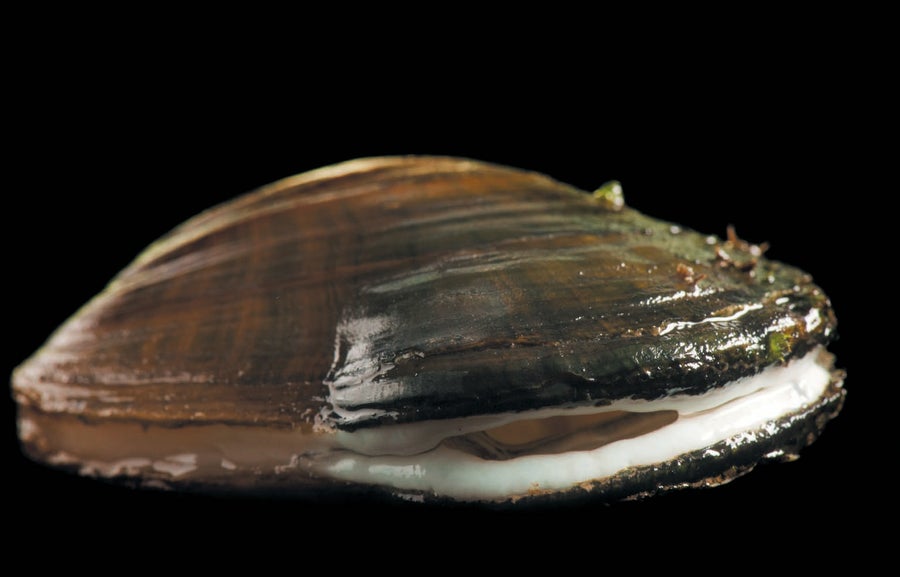
Oyster Mussel. Epioblasma capsaeformis. Listed as Endangered: 1997. Status: Still endangered. Credit: © Joel Sartore/National Geographic Photo Ark
The second initiative that could promote species conservation is already underway: bringing landowners into the fold. Most wildlife habitat east of the Rocky Mountains is on private land. That's also where habitat loss is happening fastest. Some experts say conservation isn't likely to succeed unless the FWS works more collaboratively with landowners, adding carrots to the ESA's regulatory stick. Bean has long promoted the idea, including when he worked at the Interior Department from 2009 to early 2017. The approach started, he says, with the Red-cockaded Woodpecker.
When the ESA was passed, there were fewer than 10,000 Red-cockaded Woodpeckers left of the millions that had once lived in the Southeast. Humans had cut down the old pine trees, chiefly Longleaf Pine, that the birds excavate cavities in for roosting and nesting. An appropriate tree has to be large, at least 60 to 80 years old, and there aren't many like that left. The longleaf forest, which once carpeted up to 90 million acres from Virginia to Texas, has been reduced to less than three million acres of fragments.
In the 1980s the ESA wasn't helping because it provided little incentive to preserve forest on private land. In fact, Bean says, it did the opposite: landowners would sometimes clear-cut potential woodpecker habitat just to avoid the law's constraints. The woodpecker population continued to drop until the 1990s. That's when Bean and his Environmental Defense Fund colleagues persuaded the FWS to adopt “safe-harbor agreements” as a simple solution. An agreement promised landowners that if they let pines grow older or took other woodpecker-friendly measures, they wouldn't be punished; they remained free to decide later to cut the forest back to the baseline condition it had been in when the agreement was signed.
That modest carrot was inducement enough to quiet the chainsaws in some places. “The downward trends have been reversed,” Bean says. “In places like South Carolina, where they have literally hundreds of thousands of acres of privately owned forest enrolled, Red-cockaded Woodpecker numbers have shot up dramatically.”
The woodpecker is still endangered. It still needs help. Because there aren't enough old pines, land managers are inserting lined, artificial cavities into younger trees and sometimes moving birds into them to expand the population. They are also using prescribed fires or power tools to keep the longleaf understory open and grassy, the way fires set by lightning or Indigenous people once kept it and the way the woodpeckers like it. Most of this work is taking place, and most Red-cockaded Woodpeckers are still living, on state or federal land such as military bases. But a lot more longleaf must be restored to get the birds delisted, which means collaborating with private landowners, who own 80 percent of the habitat.
Leo Miranda-Castro, who retired last December as director of the FWS's southeast region, says the collaborative approach took hold at regional headquarters in Atlanta in 2010. The Center for Biological Diversity had dropped a “mega petition” demanding that the FWS consider 404 new species for listing. The volume would have been “overwhelming,” Miranda-Castro says. “That's when we decided, ‘Hey, we cannot do this in the traditional way.’ The fear of listing so many species was a catalyst” to look for cases where conservation work might make a listing unnecessary.
An agreement affecting the Gopher Tortoise shows what is possible. Like the woodpeckers, it is adapted to open-canopied longleaf forests, where it basks in the sun, feeds on herbaceous plants and digs deep burrows in the sandy soil. The tortoise is a keystone species: more than 300 other animals, including snakes, foxes and skunks, shelter in its burrows. But its numbers have been declining for decades.
Urbanization is the main threat to the tortoises, but timberland can be managed in a way that leaves room for them. Eager to keep the species off the list, timber companies, which own 20 million acres in its range, agreed to figure out how to do that—above all by returning fire to the landscape and keeping the canopy open. One timber company, Resource Management Service, said it would restore Longleaf Pine on about 3,700 acres in the Florida panhandle, perhaps expanding to 200,000 acres eventually. It even offered to bring other endangered species onto its land, which delighted Miranda-Castro: “I had never heard about that happening before.” Last fall the FWS announced that the tortoise didn't need to be listed in most of its range.
Miranda-Castro now directs Conservation Without Conflict, an organization that seeks to foster conversation and negotiation in settings where the ESA has more often generated litigation. “For the first 50 years the stick has been used the most,” Miranda-Castro says. “For the next 50 years we're going to be using the carrots way more.” On his own farm outside Fort Moore, Ga., he grows Longleaf Pine—and Gopher Tortoises are benefiting.
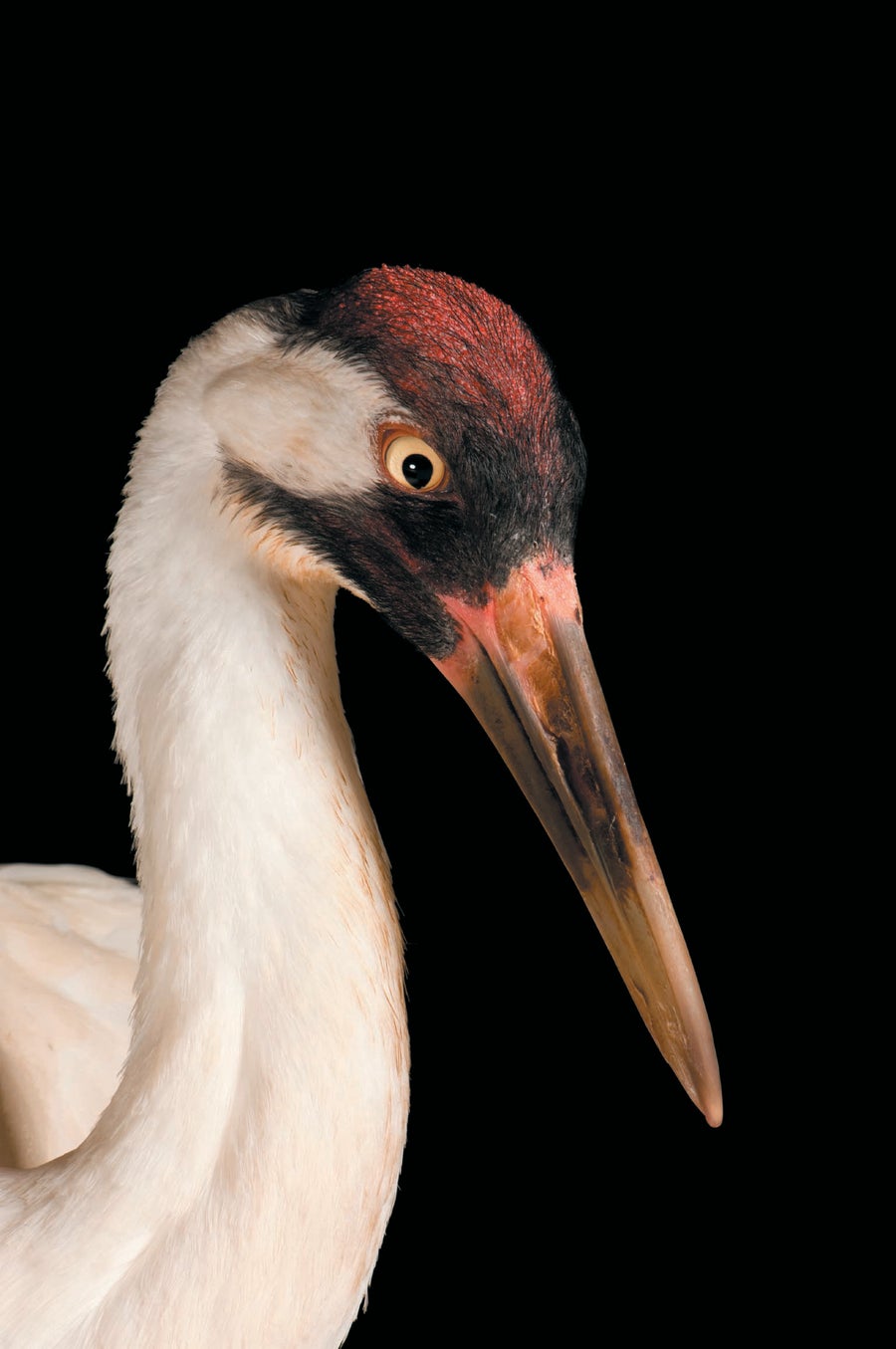
Whooping Crane. Grus americana. Listed as Endangered: 1967. Status: Still endangered. Credit: © Joel Sartore/National Geographic Photo Ark
The Center for Biological Diversity doubts that carrots alone will save the reptile. It points out that the FWS's own models show small subpopulations vanishing over the next few decades and the total population falling by nearly a third. In August 2023 it filed suit against the FWS, demanding the Gopher Tortoise be listed.
The FWS itself resorted to the stick this year when it listed the Lesser Prairie-Chicken, a bird whose grassland home in the Southern Plains has long been encroached on by agriculture and the energy industry. The Senate promptly voted to overturn that listing, but President Biden promised to veto that measure if it passes the House.
B ehind the debates over strategy lurks the vexing question: Can we save all species? The answer is no. Extinctions will keep happening. In 2021 the FWS proposed to delist 23 more species—not because they had recovered but because they hadn't been seen in decades and were presumed gone. There is a difference, though, between acknowledging the reality of extinction and deliberately deciding to let a species go. Some people are willing to do the latter; others are not. Bean thinks a person's view has a lot to do with how much they've been exposed to wildlife, especially as a child.
Zygmunt Plater, a professor emeritus at Boston College Law School, was the attorney in the 1978 Snail Darter case, fighting for hundreds of farmers whose land would be submerged by the Tellico Dam. At one point in the proceedings Justice Lewis F. Powell, Jr., asked him, “What purpose is served, if any, by these little darters? Are they used for food?” Plater thinks creatures such as the darter alert us to the threat our actions pose to them and to ourselves. They prompt us to consider alternatives.
The ESA aims to save species, but for that to happen, ecosystems have to be preserved. Protecting the Northern Spotted Owl has saved at least a small fraction of old-growth forest in the Pacific Northwest. Concern about the Red-cockaded Woodpecker and the Gopher Tortoise is aiding the preservation of longleaf forests in the Southeast. The Snail Darter wasn't enough to stop the Tellico Dam, which drowned historic Cherokee sites and 300 farms, mostly for real estate development. But after the controversy, the presence of a couple of endangered mussels did help dissuade the TVA from completing yet another dam, on the Duck River in central Tennessee. That river is now recognized as one of the most biodiverse in North America.
The ESA forced states to take stock of the wildlife they harbored, says Jim Williams, who as a young biologist with the FWS was responsible for listing both the Snail Darter and mussels in the Duck River. Williams grew up in Alabama, where I live. “We didn't know what the hell we had,” he says. “People started looking around and found all sorts of new species.” Many were mussels and little fish. In a 2002 survey, Stein found that Alabama ranked fifth among U.S. states in species diversity. It also ranks second-highest for extinctions; of the 23 extinct species the FWS recently proposed for delisting, eight were mussels, and seven of those were found in Alabama.
One morning this past spring, at a cabin on the banks of Shoal Creek in northern Alabama, I attended a kind of jamboree of local freshwater biologists. At the center of the action, in the shade of a second-floor deck, sat Sartore. He had come to board more species onto his photo ark, and the biologists—most of them from the TVA—were only too glad to help, fanning out to collect critters to be decanted into Sartore's narrow, flood-lit aquarium. He sat hunched before it, a black cloth draped over his head and camera, snapping away like a fashion photographer, occasionally directing whoever was available to prod whatever animal was in the tank into a more artful pose.
As I watched, he photographed a striated darter that didn't yet have a name, a Yellow Bass, an Orangefin Shiner and a giant crayfish discovered in 2011 in the very creek we were at. Sartore's goal is to help people who never meet such creatures feel the weight of extinction—and to have a worthy remembrance of the animals if they do vanish from Earth.
With TVA biologist Todd Amacker, I walked down to the creek and sat on the bank. Amacker is a mussel specialist, following in Williams's footsteps. As his colleagues waded in the shoals with nets, he gave me a quick primer on mussel reproduction. Their peculiar antics made me care even more about their survival.
There are hundreds of freshwater mussel species, Amacker explained, and almost every one tricks a particular species of fish into raising its larvae. The Wavy-rayed Lampmussel, for example, extrudes part of its flesh in the shape of a minnow to lure black bass—and then squirts larvae into the bass's open mouth so they can latch on to its gills and fatten on its blood. Another mussel dangles its larvae at the end of a yard-long fishing line of mucus. The Duck River Darter Snapper—a member of a genus that has already lost most of its species to extinction—lures and then clamps its shell shut on the head of a hapless fish, inoculating it with larvae. “You can't make this up,” Amacker said. Each relationship has evolved over the ages in a particular place.
The small band of biologists who are trying to cultivate the endangered mussels in labs must figure out which fish a particular mussel needs. It's the type of tedious trial-and-error work conservation biologists call “heroic,” the kind that helped to save California Condors and Whooping Cranes. Except these mussels are eyeless, brainless, little brown creatures that few people have ever heard of.
For most mussels, conditions are better now than half a century ago, Amacker said. But some are so rare it's hard to imagine they can be saved. I asked Amacker whether it was worth the effort or whether we just need to accept that we must let some species go. The catch in his voice almost made me regret the question.
“I'm not going to tell you it's not worth the effort,” he said. “It's more that there's no hope for them.” He paused, then collected himself. “Who are we to be the ones responsible for letting a species die?” he went on. “They've been around so long. That's not my answer as a biologist; that's my answer as a human. Who are we to make it happen?”
Robert Kunzig is a freelance writer in Birmingham, Ala., and a former senior editor at National Geographic, Discover and Scientific American .
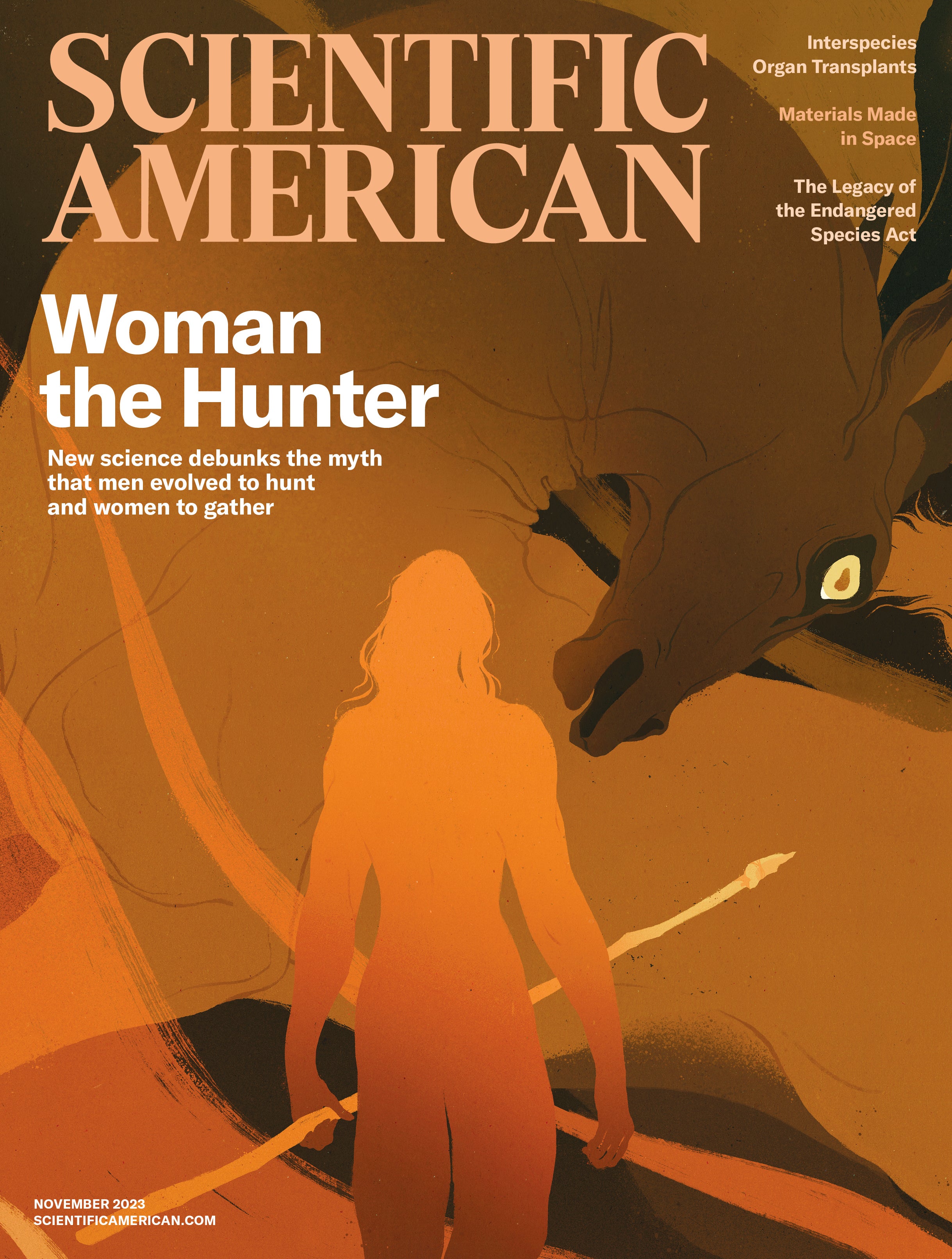
Environment: Endangered Species Essay
Globally, over 14,000 animal species face a risk of extinction. The reasons for the near extinction include poaching, habitat loss, human-wildlife conflict, pollution, diseases, climate change, and low birth rates (IUCN, 2021). Some of the most endangered species include the Javan rhino, African elephants, black rhino, snow leopards, orangutans, the vaquita, Amur leopards, and the eastern lowland gorillas. With the appropriate conservation measure, endangered animals may increase over time.
Captive breeding and reintroduction are among the most effective conservation approaches. They involve capturing, breeding, and rearing endangered animals in wildlife reserves, zoos, or aquariums to help increase their numbers. After a significant number is raised, the animals can then be released back to their natural habitats. For example, in 1982, only 22 California condors existed in the wild; however, captive breeding increased the number to 425 in 2014 (Association of Zoos & Aquarium, n.d). Thus, when threats are reduced, the rare species can improve in numbers.
Habitat protection is critical in ensuring the safety of endangered animals. Protected areas where endangered species can be placed include nature reserves, national parks, and wildlife refuges. There are various marine reserves and protected areas that prohibit fishing, thus safeguarding the marine species. In this case, New Zealand has several marine reserves that protect sea turtles, aquatic mammals, and some fish species such as manta rays and white pointer sharks (Ministry for Primary Industries, n.d). Additionally, some laws and regulations safeguard wildlife at state, national, and global levels to prevent animal extinction. In this case, CITES or the Washington convention significantly regulates the global trade of wild animals. This treaty restricts and controls any trade involving endangered species to ensure they do not become extinct
In conclusion, human activity and climate change continually threaten some wild animals’ survival. Nonetheless, appropriate conservation methods such as captive breeding and habitat protection can ensure the continuous reproduction of these species. The enactment of state, national and global laws that safeguard wild animals also promotes the survival of these species. Human beings have a responsibility to ensure the protection of wild animals and their habitats.
Global warming is one of the biggest threats to animal and plant survival. The accumulation of greenhouse gases into the atmosphere, deforestation, and increased agricultural activities are major contributors to this phenomenon. The increased earth temperature associated with global warming has led to climate change resulting in several natural calamities. However, the threat of global warming can be reduced by using renewable energy, recycling, planting more trees, and lowering the emission of greenhouse gases.
Global warming has significant adverse impacts on human beings and the environment. The extreme heat associated with climate change increases complications from underlying respiratory and heart diseases such as renal failure and asthma and may cause other heat-related disorders. Global warming also increases the risk of storms and drought, affecting food supply, which may cause death to both humans and animals (Global Climate Change, 2021). It has also been linked to ocean acidification, increased ocean temperature, and rising sea levels. Such occurrences have led to the death of a significant number of marine life.
Rather than human actions, global warming may result from natural forces. Human activities such as deforestation, industrial processes, and agricultural activities have long been attributed to climate change. However, there are claims that complex gravitational interactions, particularly alterations in the earth’s orbit, torque, and axial tilt, may also influence climate change resulting in increased temperature (Neaves, 2017). Gradual shifts in the earth’s orbit combined with its axial tilt places the south and north poles more directly to the sun resulting in temperature extremes.
In conclusion, global warming has adverse effects on humans and nature. It exposes humans to heat-related diseases and increases complications of respiratory illnesses such as asthma. Climate change depletes vegetation causing food shortage and death to humans and animals. Similarly, it causes ocean warming and acidification, which destroys marine life. Although some natural forces such as shifts in the earth’s orbit and axis may trigger temperature changes, human activities are the greatest contributors to global warming.
Association of Zoos & Aquarium (n.d). Reintroduction programs . Web.
Ministry for Primary Industries. (n.d). Protecting marine life . Web.
Neaves, T., T. (2017). The climate is changing, but not just because of humans. Here’s why that matters . NBC News . Web.
International Union for Conservation of Nature. (2021). African elephant species now endangered and critically endangered – IUCN Red List . Web.
Global Climate Change. (2021). The effects of climate change . Web.
- Ocean Acidification: Marine Calcification Process
- The Role of Zoos in Endangered Species Protection
- The Axial Age and World Religions
- Human Impact on Seismic Activity
- Is Fashion Destroying the Planet?
- Reducing Personal Impact on the Environment
- Poor Waste Disposal and Pollution in California
- Food Production and The Environment
- Chicago (A-D)
- Chicago (N-B)
IvyPanda. (2022, November 16). Environment: Endangered Species. https://ivypanda.com/essays/environment-endangered-species/
"Environment: Endangered Species." IvyPanda , 16 Nov. 2022, ivypanda.com/essays/environment-endangered-species/.
IvyPanda . (2022) 'Environment: Endangered Species'. 16 November.
IvyPanda . 2022. "Environment: Endangered Species." November 16, 2022. https://ivypanda.com/essays/environment-endangered-species/.
1. IvyPanda . "Environment: Endangered Species." November 16, 2022. https://ivypanda.com/essays/environment-endangered-species/.
Bibliography
IvyPanda . "Environment: Endangered Species." November 16, 2022. https://ivypanda.com/essays/environment-endangered-species/.
Home — Essay Samples — Environment — Endangered Species — Endangered Animals: The Causes And How To Protect
Endangered Animals: The Causes and How to Protect
- Categories: Endangered Species
About this sample

Words: 541 |
Published: Dec 16, 2021
Words: 541 | Page: 1 | 3 min read
Works Cited:
- Baumeister, R. F., Gailliot, M., DeWall, C. N., & Oaten, M. (2006). Self-regulation and personality: How interventions increase regulatory success, and how depletion moderates the effects of traits on behavior. Journal of Personality, 74(6), 1773–1801.
- Duckworth, A. L., & Seligman, M. E. P. (2005). Self-discipline outdoes IQ in predicting academic performance of adolescents. Psychological Science, 16(12), 939–944.
- Emerson, R. W. (1841). Self-Reliance. Essays: First Series. https://www.emersoncentral.com/selfreliance.htm
- Goleman, D. (2013). Focus: The Hidden Driver of Excellence. HarperCollins Publishers.
- Hagger, M. S., Wood, C., Stiff, C., & Chatzisarantis, N. L. D. (2010). Ego depletion and the strength model of self-control: A meta-analysis. Psychological Bulletin, 136(4), 495–525.
- Hofmann, W., Baumeister, R. F., Förster, G., & Vohs, K. D. (2012). Everyday temptations: An experience sampling study of desire, conflict, and self-control. Journal of Personality and Social Psychology, 102(6), 1318–1335.
- McGonigal, K. (2012). The Willpower Instinct: How Self-Control Works, Why It Matters, and What You Can Do to Get More of It. Avery.
- Mischel, W., Shoda, Y., & Rodriguez, M. L. (1989). Delay of gratification in children. Science, 244(4907), 933–938.
- Tangney, J. P., Baumeister, R. F., & Boone, A. L. (2004). High self‐control predicts good adjustment, less pathology, better grades, and interpersonal success. Journal of Personality, 72(2), 271–322.
- Vohs, K. D., Baumeister, R. F., & Schmeichel, B. J. (2012). Motivation, personal beliefs, and limited resources all contribute to self-control. Journal of Experimental Social Psychology, 48(4), 943–947.

Cite this Essay
Let us write you an essay from scratch
- 450+ experts on 30 subjects ready to help
- Custom essay delivered in as few as 3 hours
Get high-quality help

Prof Ernest (PhD)
Verified writer
- Expert in: Environment

+ 120 experts online
By clicking “Check Writers’ Offers”, you agree to our terms of service and privacy policy . We’ll occasionally send you promo and account related email
No need to pay just yet!
Related Essays
1 pages / 368 words
2 pages / 881 words
2 pages / 1259 words
4 pages / 2045 words
Remember! This is just a sample.
You can get your custom paper by one of our expert writers.
121 writers online
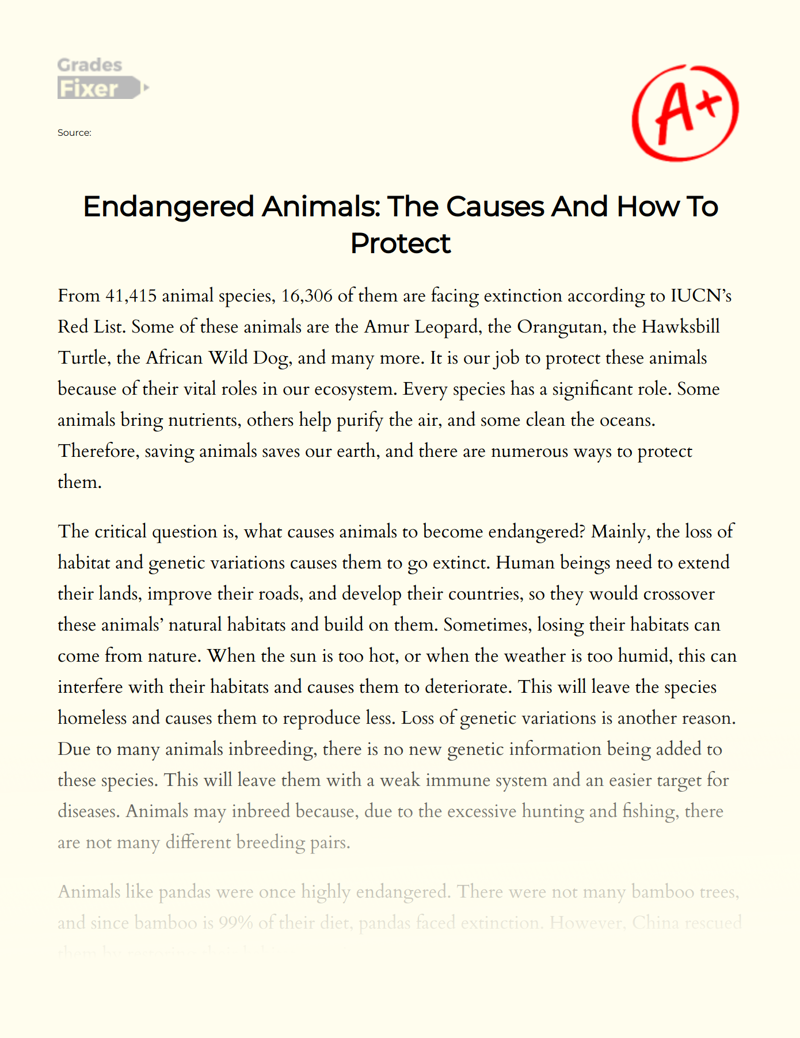
Still can’t find what you need?
Browse our vast selection of original essay samples, each expertly formatted and styled
Related Essays on Endangered Species
Imagine you are an animal. You’ve been wandering the wastelands, which used to be a lush green forest, what used to be your home. Its late spring, right about time for mating season. Normally, you’d be out calling for a mate, [...]
Giant pandas, or Ailuropoda, are one of the most beloved and iconic animals in the world. Their distinctive black and white fur, gentle demeanor, and unique diet of bamboo have captivated people around the globe. However, the [...]
Red pandas are “raccoon-like” animals with fluffy fur ranging from orange, brown, black, and white. The red panda is found in Central China, Nepal, Burma, and other places in the surrounding area. They live in isolated mountain [...]
The job of a marine biologist is to study and conserve the ocean, and all the creatures within it. While their main focus is the water, a lot of their work is conducted on dry land, as they fight for regional laws, fisherman [...]
Endangerment is a bigger issue, one of them that includes the animals as well as the atmosphere where they interact with each other and live. To solve or elevate this problem every aspect related to this need to be studied. So, [...]
In the early days, estimates of abundance of species were derived at large geographic scales through the administration of questionnaires to local people (Sugiyama and Soumah 1988). Scientists have unanimously agreed that for [...]
Related Topics
By clicking “Send”, you agree to our Terms of service and Privacy statement . We will occasionally send you account related emails.
Where do you want us to send this sample?
By clicking “Continue”, you agree to our terms of service and privacy policy.
Be careful. This essay is not unique
This essay was donated by a student and is likely to have been used and submitted before
Download this Sample
Free samples may contain mistakes and not unique parts
Sorry, we could not paraphrase this essay. Our professional writers can rewrite it and get you a unique paper.
Please check your inbox.
We can write you a custom essay that will follow your exact instructions and meet the deadlines. Let's fix your grades together!
Get Your Personalized Essay in 3 Hours or Less!
We use cookies to personalyze your web-site experience. By continuing we’ll assume you board with our cookie policy .
- Instructions Followed To The Letter
- Deadlines Met At Every Stage
- Unique And Plagiarism Free
Accelerating extinction rate triggers domino effect of biodiversity loss

Facebook Twitter Print Email
While nearly one million species are currently at risk of extinction, the United Nations University (UNU) in Bonn is drawing attention to “co-extinctions”: the chain reaction occurring when the complete disappearance of one species affects another.
The issue is in the spotlight ahead of the International Day for Biological Diversity , observed annually on 22 May, and covered in the most recent edition of UNU’s Interconnected Disaster Risks report.
Among the animals at risk is the gopher tortoise, one of the oldest living species on the planet. This tragic story of biodiversity loss is unfolding at the heart of the coastal plains of the southern United States.
Ecosystem ‘architect’
Their reduced number is not just problematic for the survival of the tortoise as a species, however, as these charismatic creatures also play a vital role in preserving the delicate balance of their coastal realm.
Gopher tortoises are not merely occupants of their habitat; they are architects, sculpting ecosystems and providing sanctuaries for over 350 other species. With their front legs functioning like shovels, they dig burrows that range in size from 20 to 30 feet (6 to 9 metres) long and from 6 to 8 feet (1.8 to 2.5 metres) deep.
From small insects to larger amphibians, each organism plays a vital role in the ecosystem's intricate web of life these burrows provide. For some, the burrows of the gopher tortoise are a safe haven for breeding and nurturing offspring, while for others, they offer respite from predators and the elements.
Should the gopher tortoise vanish, it is likely a domino effect would be felt throughout the ecosystem.
Among the most vulnerable is the critically endangered dusky gopher frog, a species already teetering on the brink of extinction. Reliant on the tortoise's burrows for shelter and survival, the disappearance of the tortoise would most likely put the frog’s survival at risk too.

The role of humans
In shedding more light on co-extinctions, UNU said that intense human activities, such as land-use change, overexploitation, climate change, pollution and the introduction of invasive species, is causing an extinction acceleration that is at least tens to hundreds of times faster than the natural process of extinctions.
In the last 100 years, over 400 vertebrate species were lost, for example. The report therefore includes accelerated extinctions among its six interconnected ‘risk tipping points’.
Such points are reached when the systems that humanity relies on cannot buffer risks and stop functioning like expected – mainly as a result of human actions.
Extinction breeds extinction
Ecosystems are built on intricate networks of connections between different species, as the gopher tortoise-dusky gopher frog example indicates.
The domino effect could lead to more species going extinct and eventually even to the collapse of entire ecosystems.
With nearly one million plant and animal species currently under threat, the ripple effect of the extinction of a single species can affect countless others, disrupting vital ecological functions.
The endangered sea otter provides another example of intricate dependencies within ecosystems. Calling the Pacific kelp forests their home, they were once plentiful, but are now locally endangered due to being relentlessly hunted for their fur in the past.
In a finely tuned ecological dance, sea otters prey on sea urchins, halting the unrestrained growth of sea urchin populations. Without the presence of otters, these spiky grazers run rampant, transforming lush kelp forests into desolate ‘urchin barrens’.
But the demise of sea otters would have impacts that extend far beyond the disappearance of kelp alone, UNU said. Over1,000 species– including sharks, turtles, seals, whales, birds, and a multitude of fish– rely on these underwater havens for their very existence.
Creating the future we want
Addressing the biodiversity crisis demands a multifaceted approach that recognizes the interconnectedness of risks and solutions.
The theme of the International Day for Biological Diversity calls for everyone to support implementation of the Biodiversity Plan , adopted in 2022, which sets goals and concrete measures to stop and reverse the loss of nature by 2050.
One of the goals includes reducing the extinction rate of all species tenfold by mid-century and increasing the abundance of native wild species to healthy and resilient levels, said Zita Sebesvari, Deputy Director of UNU’s Institute for Environment and Human Security and lead author of the Interconnected Disaster Risks report.
“While adaptation strategies, such as restoring and protecting green corridors between animal habitats offer some respite, tackling underlying drivers of extinction remains crucial, because this goal cannot be reached as long as we risk accelerating extinctions,” she explained.
In the long term, avoiding extinctions and co-extinctions will be the only realistic solution to halt biodiversity loss, which requires a shift of mindsets.
“Conservation efforts must extend beyond individual species to encompass entire ecosystems”, Ms. Sebesvari said.
“Urgent and decisive action is needed to preserve the resilience of ecosystems and ensure the survival of our planet’s diverse web of life. Embracing nature as an integral part of our culture is essential to secure a sustainable future, recognizing that our fate is inevitably intertwined with the fate of the natural world.”
- biodiversity
Take 10% OFF— Expires in h m s Use code save10u during checkout.
Chat with us
- Live Chat Talk to a specialist
- Self-service options
- Search FAQs Fast answers, no waiting
- Ultius 101 New client? Click here
- Messenger
International support numbers
For reference only, subject to Terms and Fair Use policies.
- How it Works
Learn more about us
- Future writers
- Explore further
Ultius Blog
Sample environmental science essay: animals most in danger of extinction.

Select network
The Earth is home to billions of species. While scientists have admitted that we have yet to discover all that is out there, they have also confirmed that the earth’s species is going extinct at a rate of 0.01%/year, meaning that a minimum of two thousand species go extinct every year (“How many species are we losing?”). Animals that are in the most danger of extinction are classified as "critically endangered," meaning they face the highest risk of extinction in the wild. The animals listed in this provided sample essay by Ultius are in the highest danger of becoming extinct than any other animal species on earth.
Which animals are the most endangered?
The amur leopard.
The Amur leopard is the number one most critically endangered animal in the world. When people think of leopards, they usually think of a great, spotted animal stalked the savannas of Africa. The Amur leopard, though, resides in the Russian Far East and has adapted to the temperate forests of the species northern territory. Like other leopards, the Amur leopard can sprint as fast as almost forty miles per hour and can leap more than ten feet vertically into the air and nineteen feet horizontally (“Amur Leopard”). The Amur leopard lives in temperate broadleaf and mixed forests in a mountainous region. They are strong, nimble, and clever animals that carry their unfinished kills away and hide them away from other predators. Amur leopards are solitary animals, though it has been reported that males remain with females after mating and sometimes help with the rearing of their young. Several males will sometimes follow and fight over one specific female. The leopards will live between ten and fifteen years in the wild and can live up to twenty years in captivity (“Amur Leopard”). Other names for the Amur leopard include the Korean leopard, the Far East leopard, and the Manchurian leopard.
Threats facing the Amur leopard are illegal wildlife trade and prey scarcity. The leopard is poached for its beautiful, high-value fur. One illegal Amur leopard skin sells for more than one thousand dollars (“Amur Leopard”). Their habitat is rather accessible to humans, as it is surrounded by villages and agricultural fields. This close proximity with humans makes poaching a serious problem for the Amur leopard. The lack of prey also takes a serious toll on the Amur population. Its former range of China no longer has the prey to support large cats due to forest reduction for logging. If the Amur leopard hopes to survive, it needs to be able to repopulate its old range, but the availability of prey needs to increase first.
There are approximately sixty Amur leopards left in the wild. This is more than double their population in 2007 , when there were less than thirty Amur leopards left (“Amur Leopard- World’s Rarest Cat- Doubles in Population”). Recently, an additional eight to twelve were counted in China but have not yet been confirmed. In order to find these numbers, cameras were hidden over more than nine hundred thousand acres of land that is known leopard habitat. Thousands of images were reviewed and approximately sixty different animals were identified by unique spot patterns in their fur. Barney Long, Director of Species Protection and Asian Species Conservation for the World Wildlife Fund , said that,
“Such a strong rebound in Amur leopard numbers is further proof that even the most critically endangered big cats can recover if we protect their habitat and work together on conservation efforts.” (“Amur Leopard- World’s Rarest Cat- Doubles in Population”).
Researchers are now focusing on counting leopard populations in China in order to get more accurate numbers.
Related Content: Learn more about illegal poaching and the ivory trade .
The Javan rhino
The second most critically endangered animal in the world is the Javan rhino. Like the Amur leopard, the Javan rhino’s population is dwindling at slightly more than sixty. The entire population lives in Ujung Kulon National Park in Java, Indonesia (“Javan Rhino”). Their grey coloring enhances the appearance of armor created by the loose folds of their skin, which resembles plating. Their horns grow to approximately ten inches and their habitat consists of tropical forests.
There are a number of threats facing the Javan rhino. The most pressing is the illegal wildlife trade . During colonial times, they were killed by trophy hunters, for their prized horns which are used for traditional Asian medicines, and as agricultural pests. In 2010, poaching completely eliminated the entire population of a Javan rhino subspecies in Vietnam (“Javan Rhino”). Other threats include reduced genetic diversity, which can make it hard for the remaining population to reproduce, and disease caused by wild cattle in the park. The species is also threatened by natural disasters that are common in Ujung Kulon National Park and invasive species that wiped out the rhinos’ food source in almost half the park (“Javan Rhino”).
The saola is a large mammal that resembles a squat antelope, though they are more closely related to cattle. Both males and females have two parallel horns that can reach twenty inches in length. They are a warm brown color with white markings on their faces. Saola are found exclusively in the Annamite Mountains in Laos and Vietnam (“Saola”). They were not discovered until 1992 when a joint survey conducted by the World Wildlife Foundation and the Ministry of Forestry in Vietnam. The research team uncovered a skull that had unusually long horns. It was the first new large mammal science if over half a century and is considered one of the biggest zoological discoveries of the 20th centuries (“Saola”).
Despite only being recently discovered, there are only between a few dozen and a few hundred saola left in the wild. Threats to the population include habitat loss and hunting. Their native habitat is constantly being reduced for industry and agriculture, pushing the animals into a smaller and smaller space. Their habitat has become fragmented, making it easier for hunters to access them and affecting the population’s genetic diversity (“Saola”). Saola are often caught in traps set for other animals like boar and deer. There is also an increase in hunting to supply the illegal trade and meet the traditional medicine demand in eastern medicine.
The Cross River gorilla
Cross River gorillas are very similar in appearance to other gorillas, but differ in their tooth and skull dimensions. They can grow to be between four and five and a half feet tall and weigh more than four hundred pounds (“Cross River Gorilla”). Until very recently, scientists have been unable to get an accurate count of the Cross River gorilla population because the animals are wary of humans and prefer a more rugged territory that is harder to access. Researchers instead have to use indirect sings like estimated range sizes and nest counts to determine that there are approximately two to three hundred Cross River gorillas (“Cross River Gorilla”). They live an at least eleven family groups in an area of three thousand square miles across the lowlands forests of Nigeria and Cameroon.
The main threats facing Cross River gorillas are inbreeding and hunting. Because of the small population, there is a risk for a decrease in genetic diversity that can make it difficult for the species to healthily reproduce. They tend to keep to their own groups and hardly interact with the others at all. While hunting and killing gorillas is illegal in their native territory, it is not uncommon for these laws to go unenforced. Conservation efforts have caused the hunting to decline, though. Still, because there is such a small population, the killing of even one gorilla can be detrimental to the species (“Cross River Gorilla”). The World Wildlife Foundation, along with the governments of Nigeria and Cameroon, has focused their efforts on securing a safe habitat for the gorillas and created a protected area across the two countries for the gorillas to live safely.
The Mountain gorilla
Like their Cross River cousins, the Mountain gorilla can grow to between four and five and a half feet tall and more than four hundred pounds. They live in the forested area high in the mountains at elevations between eight thousand and twelve thousand feet. They have more hair that is fuller and thicker than the hair of other apes, helping them survive in temperatures below freezing , which are not uncommon for their habitat (“Mountain Gorilla”). Humans continue to breach the Mountain gorilla’s territory, pushing them further and further up the mountains where conditions are dangerous and often deadly.
There are several factors that contribute to the dwindling Mountain gorilla population. The war in Rwanada in the early 1990s along with the Democratic Republic of Congo’s civil unrest sent refugees into the mountains in huge numbers, which contributed to poaching and loss of habitat (“Mountain Gorilla”). Parts of the gorillas’ environment have been overtaken by rebel forces, making it dangerous and difficult to conduct surveys of the population or continue with conservation efforts. Further disrupting the gorillas’ habitat is the harvesting of charcoal for fuel, which is quickly destroying the land. In 2004, almost four thousand acres of gorilla habitat were cleared or devastated (“Mountain Gorilla”). Another threat facing the population is disease. The more they come into contact with humans, the more diseases gorillas contract in severe forms. Mountain gorillas can even die from the common cold (“Mountain Gorilla”). However, increased veterinary care has caused their survival rate to rise.
The Black rhino
There are about five thousand black rhinos left in the world today. European hunters are responsible for the massive population decline when it was not uncommon for five or six rhinos to be killed every day for amusement or food (“Black Rhino”). The majority of rhinoceros slaughter took place in the early twentieth century by settlers. Black rhinos can grow up to just above five feet tall and weigh between seventeen hundred pounds to over three thousand. They live in subtropical and tropical grasslands, deserts, savannas, and shrublands.
The main threats to their population are habitat loss and the illegal wildlife trade. (Discover how habitat loss impacts species ). The changes in habitat have mainly been due to an over-flooding of landless people. This decreases the amount of safe habitat for the rhinos and puts them at risk for poaching. Black rhinos have two horns, sometimes three, making them desirable candidates for poachers. Between 1970 and 1992, ninety six percent of the black rhinos in Africa were killed (“Black Rhino”). War and political instability have made conservation efforts difficult and recent rises in poaching incidents has nearly reversed efforts that have already been made.
A precarious fate
The most critically endangered animals in the world are in desperate need of help before they are wiped off the earth forever. The main causes of their rapid population decline are habitat loss because of humans or illegal hunting and poaching by humans and if something is not done soon, their fate is certainly less than promising. With thousands of species going extinct every year, these animals could be next.
If you liked this read and need help with your writing, consider checking out our extensive essay help section .
Works Cited
“Amur Leopard.” WWF . World Wildlife Fund, 2016. Web. 30 May 2016. https://www.worldwildlife.org/species/amur-leopard.
“Amur Leopard- World’s Rarest Cat- Doubles in Population.” WWF . World Wildlife Fund, 23 Feb. 2015. Web. 30 May 2016. https://www.worldwildlife.org/stories/amur-leopard-world-s-rarest-cat-doubles-in-population.
“Black Rhino.” Bagheera: An Education Website About Endangered Species and the Efforts to Save Them . Quattro Theme, 2016. Web. 31 May 2016. http://www.bagheera.com/inthewild/van_anim_rhino.htm.
“Cross River Gorilla.” WWF . World Wildlife Fund, 2016. Web. 30 May 2016. https://www.worldwildlife.org/species/cross-river-gorilla.
“Javan Rhino.” Edge of Existence . The Zoological Society of London, n.d. 31 May 2016. http://www.edgeofexistence.org/mammals/species_info.php?id=11.
“Mountain Gorilla.” WWF . World Wildlife Fund, 2016. Web. 30 May 2016. https://www.worldwildlife.org/species/mountain-gorilla.
“Saola.” WWF . World Wildlife Fund, 2016. Web. 30 Jun. 2016. https://www.worldwildlife.org/species/saola.
Cite This Post
This blog post is provided free of charge and we encourage you to use it for your research and writing. However, we do require that you cite it properly using the citation provided below (in MLA format).
Ultius, Inc. "Sample Environmental Science Essay: Animals Most in Danger of Extinction." Ultius Blog . Ultius | Custom Writing and Editing Services, 30 Jun. 2016. Web. <https://www.ultius.com/ultius-blog/entry/sample-environmental-science-essay-animals-most-in-danger-of-extinction.html>
Thank you for practicing fair use.
This citation is in MLA format, if you need help with MLA format, click here to follow our citation style guide.
https://www.ultius.com/ultius-blog/entry/sample-environmental-science-essay-animals-most-in-danger-of-extinction.html
- Chicago Style
Ultius, Inc. "Sample Environmental Science Essay: Animals Most in Danger of Extinction." Ultius | Custom Writing and Editing Services. Ultius Blog, 30 Jun. 2016. https://www.ultius.com/ultius-blog/entry/sample-environmental-science-essay-animals-most-in-danger-of-extinction.html
Copied to clipboard
Click here for more help with MLA citations.
Ultius, Inc. (2016, June 30). Sample Environmental Science Essay: Animals Most in Danger of Extinction. Retrieved from Ultius | Custom Writing and Editing Services, https://www.ultius.com/ultius-blog/entry/sample-environmental-science-essay-animals-most-in-danger-of-extinction.html
Click here for more help with APA citations.
Ultius, Inc. "Sample Environmental Science Essay: Animals Most in Danger of Extinction." Ultius | Custom Writing and Editing Services. June 30, 2016 https://www.ultius.com/ultius-blog/entry/sample-environmental-science-essay-animals-most-in-danger-of-extinction.html.
Click here for more help with CMS citations.
Click here for more help with Turabian citations.
Ultius is the trusted provider of content solutions and matches customers with highly qualified writers for sample writing, academic editing, and business writing.

Tested Daily
Click to Verify
About The Author
This post was written by Ultius.

- Writer Options
- Custom Writing
- Business Documents
- Support Desk
- +1-800-405-2972
- Submit bug report
- A+ BBB Rating!
Ultius is the trusted provider of content solutions for consumers around the world. Connect with great American writers and get 24/7 support.
© 2024 Ultius, Inc.
- Refund & Cancellation Policy
Free Money For College!
Yeah. You read that right —We're giving away free scholarship money! Our next drawing will be held soon.
Our next winner will receive over $500 in funds. Funds can be used for tuition, books, housing, and/or other school expenses. Apply today for your chance to win!
* We will never share your email with third party advertisers or send you spam.
** By providing my email address, I am consenting to reasonable communications from Ultius regarding the promotion.
Past winner

- Name Samantha M.
- From Pepperdine University '22
- Studies Psychology
- Won $2,000.00
- Award SEED Scholarship
- Awarded Sep. 5, 2018
Thanks for filling that out.
Check your inbox for an email about the scholarship and how to apply.
- Listening Tests
- Academic Tests
- General Tests
- IELTS Writing Checker
- IELTS Writing Samples
- Speaking Club
- IELTS AI Speaking Test Simulator
- Latest Topics
- Vocabularying
- 2024 © IELTS 69
Animals are in danger of extinction. Some people say we should protect only those animals which are useful to humans. Do you agree or disagree? v.1
Ielts essay animals are in danger of extinction. some people say we should protect only those animals which are useful to humans. v. 1.
- Structure your answers in logical paragraphs
- ? One main idea per paragraph
- Include an introduction and conclusion
- Support main points with an explanation and then an example
- Use cohesive linking words accurately and appropriately
- Vary your linking phrases using synonyms
- Try to vary your vocabulary using accurate synonyms
- Use less common question specific words that accurately convey meaning
- Check your work for spelling and word formation mistakes
- Use a variety of complex and simple sentences
- Check your writing for errors
- Answer all parts of the question
- ? Present relevant ideas
- Fully explain these ideas
- Support ideas with relevant, specific examples
- ? Currently is not available
- Meet the criteria
- Doesn't meet the criteria
- 7.5 band Animals are in danger of extinctions. Some people say we should protect only those animal which are useful to humans. v. 1 Many animals are indeed threatened by the risk of extinction. Some hold a belief that humans only need to safeguard certain species that benefit us. I personally disagree with this point of view because I believe that making efforts on animal conservation should not put people’s needs into considera ...
- 8 band Animals are in danger of extinctions. Some people say we should protect only those animals, which are useful to humans. v. 2 In the modern world, although many people concern about reducing the number of wild animals, others feel that the humankind only need a few types of animals for their purposes. In this reason, they are not willing to assist some types of them. However, personally, I believe that individuals should a ...
- I love commuting between languages just like I love commuting between cultures and cities. Elif Safak
- 8 band Animals are in danger of extinction. Some people say that we should protect only those animals, which are useful to humans. v. 2 From our early existence on the Earth, animals have been human companions. However, the animal kingdom is on the edge of being completely extinct. Some people, therefore, may believe that it would be better to conserve the fauna that brings benefits to humans. I am not going along with this opinion, ...
- 8 band Animals are in danger of extinction. Some people say that we should protect only those animals, which are useful to humans. v. 3 From our early existence on the Earth, animals have been human companions. However, the animal kingdom is on the edge of being completely extinct. Some people, therefore, may believe that it would be better to conserve the fauna that brings benefits to humans. I am not going along with this opinion, ...
- Language is to the mind more than light is to the eye. William Gibson
- 8 band Technology allows food to be produced in greater quantities at lower prices. Some people believe this is a positive development, while others feel that the change is harmful. v. 3
- 8 band All parents wants the best opportunities for their children. There are some people who think that schools should teach children skills but others think having a range of subjects is better for a children's future. v. 1
- Language shapes the way we think, and determines what we can think about. Benjamin Lee Whorf
- 8 band All parents want to have the best opportunities for their children. There are some people who think that schools should teach children skills but others think having a range of subjects is better for a children's future. v. 1
- 8 band With the rapid development of communication technology, e. g smart phones, tablets and other communication devices, some people believe that the disadvantages of these devices outweigh their advantages. v. 1
- Knowledge of languages is the doorway to wisdom. Roger Bacon
- Share full article
Advertisement
Supported by
The Unusual Evolutionary Journey of the Baobab Tree
New research shows the “upside-down trees” originated in Madagascar and then caught a ride on ocean currents to reach mainland Africa and Australia.

By Rachel Nuwer
Baobabs are one of the most charismatic trees on Earth, thanks in part to their unusual appearance. Their cartoonishly thick trunks are conspicuously oversized relative to their diminutive crowns, earning them the nickname “upside-down trees.” They can also live for thousands of years , contributing to their prominent place in cultural traditions and works of art.
For all the tales told about baobabs, though, their origin story has remained a mystery.
Scientists have debated for years how baobabs wound up in the places where they grow. Eight species exist around the world, and their distribution, like the trees themselves, is unusual: One species occurs across much of mainland Africa, while six are in Madagascar. The last is found faraway, in northwestern Australia.
Most researchers have hypothesized that the trees originated on mainland Africa. But findings published Wednesday in the journal Nature tell a different story. Baobabs instead most likely first evolved in Madagascar , where they diversified into different species. Two then embarked on long-distance oceanic journeys to distant continents.
“Madagascar is this wonderful natural laboratory,” said Tao Wan, a botanist at the Wuhan Botanical Garden of the Chinese Academy of Sciences and an author of the new study. He added, “In the case of baobabs, some very special geographical history on the island contributed to the species’ diversity.”
Dr. Wan and his colleagues sequenced the genomes of all eight baobab species and then used those data to understand how the trees evolved. They also investigated ecological factors that influenced the distribution of baobabs around Madagascar.
Their results indicate that baobabs’ common ancestor most likely arose in Madagascar around 21 million years ago. Competition with other plant life and factors like altitude, temperature, precipitation and volcanic activity caused new baobab species to emerge across Madagascar, as did fluctuating sea levels during various ice ages.
Baobabs probably also evolved a mutualistic relationship with lemurs that served as pollinators. Other relatively large animals, including fruit-eating bats and bush babies in Africa, began visiting baobabs’ nocturnal flowers for nectar. “One of the evolutionary innovations of baobabs was to exploit large, sugar-eating animals,” said Andrew Leitch, a plant geneticist at Queen Mary University of London, and an author of the study. “That’s an unusual thing for a plant to do.”
At some point, most likely around 12 million years ago, two species of Malagasy baobabs found their way to mainland Africa and Australia, where they evolved into the unique trees that grow there today. Most likely, multiple baobab seeds hitched rides as vegetation was transported by the Indian Ocean gyre, a current that circulates counterclockwise between Australia, South Asia and the eastern coast of Africa — exemplifying the species’ “fascinating and extraordinary long-distance dispersal patterns,” Dr. Leitch said.
“Baobabs are amazing trees, so I was excited to see this paper,” said Pamela Soltis, a botanist at the University of Florida who was not involved in the work. She added that the research offered new perspectives on baobab evolution.
In addition to filling in missing pieces of the evolutionary puzzle, the authors’ findings also raise conservation concerns. Two of the Malagasy species have alarmingly low genetic diversity, indicating that they might lack the resilience needed to adapt to climate change. A third species is also at risk of disappearing because of interbreeding with a more widespread cousin.
These three species are already listed on the International Union for Conservation of Nature’s Red List as being in danger of extinction. The new genetic findings suggest that their conservation statuses should be re-evaluated and potentially upgraded to even higher threat levels, said Ilia Leitch, a plant geneticist at the Royal Botanic Gardens in Kew and an author of the paper.
All six of the Malagasy baobab species are also being affected by an ongoing wave of extinctions that has been occurring in Madagascar for the past 2,500 years and that researchers say is mostly being driven by human activity. Several species of giant lemurs — some of which grew to gorilla-size proportions, and all of which probably served as key seed dispersers for baobabs — were hunted to extinction around 1,000 years ago. Virtually all of the forested understory that surrounded Madagascar’s baobabs has also been lost to recent development.
While species naturally come and go across evolutionary history, “that process is being exacerbated by human intervention,” Dr. Ilia Leitch said.
The sixth extinction is underway, study finds. But here's why all hope is not lost.

Global population trends among 71,000 animal species show nearly half are "sliding toward extinction," some of them at alarming rates, a new study warns .
Researchers found 48% of the species in the analysis were declining, while only 3% were increasing and 49% remain stable, according to the study published Tuesday in the journal "Biological Reviews ."
The disparity between the declining number of species and the increasing number shows "a net loss of biodiversity that is quite alarming," said Daniel Pincheira-Donoso, a study co-author and an associate professor in evolutionary biology and macroecology at Queen’s University Belfast in the United Kingdom.
The rapidly increasing imbalance signals a looming "sixth extinction," the authors said in the study, titled "More losers than winners: investigating Anthropocene defaunation through the diversity of population trends."
Although the declining species are cause for concern, Stuart Pimm, a conservation scientist for nearly 50 years who is not associated with the study, said its other findings represent good news for many species.
The study “gets past the simplistic view that everything is going to hell,” said Pimm, Doris Duke chair of conservation ecology at Duke University. "Many species − and many important species − and doing OK, or even better."
KEEP CLIMATE ON YOUR MIND: Subscribe to the weekly Climate Point newsletter
What were the study’s findings?
Population trends were analyzed in the world's mammals, birds, reptiles, amphibians, fish and insects. The study found "animal populations and whole species are declining across the tree of life."
Among its other findings:
- Biodiversity is under increasing threat from habitat destruction, invasive species, and other factors.
- The scale of decline among the animals represents "one of the most alarming consequences" of humans' impacts on the planet.
- The number of populations collapsing "is far higher than the species adaptively 'catching up.'"
- Population trends are unknown for large numbers of species, particularly in the tropics, where other species are in trouble.
- Reptiles and fish have more stable groups than some other species, but they also have a larger number of species for which population trends are unknown.
- Amphibians are seeing some of the greatest decreases in population losses: 63% of the species examined are declining.
- Of the species classified by the International Union for Conservation of Nature’s red list as "non-threatened," 33% are declining.
"Now is the pivotal time to protect the future integrity of biodiversity, and thereby the persistence of humanity," the authors concluded.
Not all bad news
The findings are "interestingly and importantly mixed," said Pimm, who is in Africa studying elephants this summer.
"Some species are in deep trouble, but we ought not to forget that we are making a lot of successes with a lot of endangered species," he said. "There are some places where things are really pretty grim but others where things are an awful lot better.
"If you’re a skylark, an iconic bird of the English countryside, you’re in trouble" because of intensive agriculture, insecticides and herbicides, Pimm said. But success stories are found among elephants in southern Africa and bald eagles, peregrine falcons and many ducks in the U.S.
"A lot of things are going better because we made it that way," and the success illustrates further strides can be made, he said. He pointed to the United Nations' goal of conserving 30% of the world's land and oceans by 2030.
Why should we care about vanishing species?
Extinctions are an "environmental global catastrophe" that will sooner or later impact our own lives, Pincheira-Donoso said. He compared the importance of biodiversity to a car's engine.
"An engine is made of very big critical bits and very small bits like screws, but all of those elements are in that engine because together they make the engine work," he said. "If you start taking small bits from it, or certainly if you take a big bit, you know your engine will fail and will end up collapsing."
The same complex interaction happens in natural ecosystems, he said. "If you start removing species from an ecosystem, it’s the equivalent to removing screws from random bits of your engine. You know it’s going to collapse because every species plays a role."
Amphibians, for example, play large roles in ecosystems, but they are declining more than any other organisms, Pincheira-Donosa said.
"The rate of extinction of amphibians is truly alarming … more than all the other vertebrates combined," he said. "In every ecosystem where you see a massive decline of amphibians, you are basically taking a lot of random screws from your engine, and that is causing a collapse."
What were the five mass extinctions?
Using the fossil record, scientists have found five periods in Earth’s geological history when many species died. According to the American Museum of Natural History, the periods and the extinctions were:
- Ordovician-silurian: 440 million years ago. Small marine organisms.
- Devonian: 365 million years ago. Many tropical marine species.
- Permian-triassic: 250 million years ago. A range of species, including many vertebrates.
- Triassic-jurassic: 210 million years ago. Vertebrate species on land.
- Cretaceous-tertiary Extinction: 65 million years ago. An estimated 50% of Earth’s plants and animals.
Dig Deeper:
Critically endangered orangutan born: 'Every birth is a monumental success'
California condors: Avian flu is killing endangered condors at alarming rate, federal data suggests
'Something different': Rare video shows courtship ritual of threatened sharks
North Atlantic right whales: Saving endangered right whales pits advocates against lobstermen
share this!
May 23, 2024
This article has been reviewed according to Science X's editorial process and policies . Editors have highlighted the following attributes while ensuring the content's credibility:
fact-checked
trusted source
Silent species face extinction: Study highlights bias in conservation research
by James Cook University
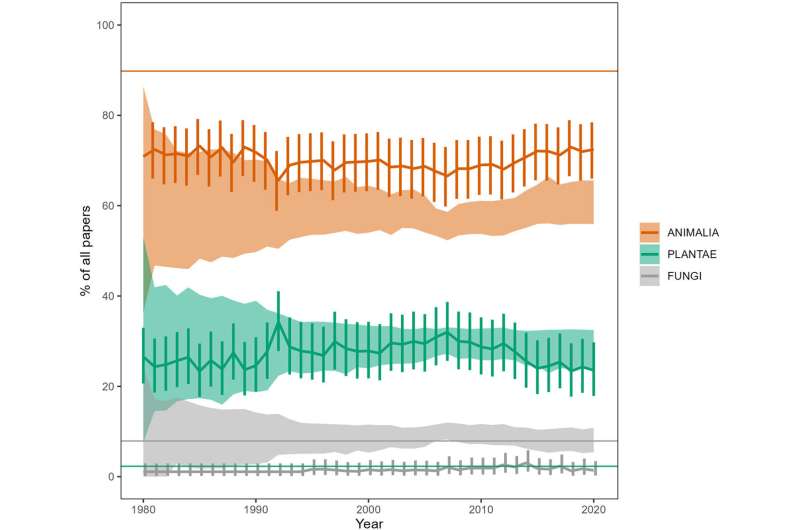
A new study warns bias towards popular animals in conservation research might see some important, but less spectacular, species suffer "silent extinctions" as their plight goes unrecognized.
Jean-Paul Hobbs, a senior research fellow at James Cook University and co-lead on the study, said despite a 35-fold increase in the number of published research articles , conservation biology research still appeared to be biased toward popular species and ecosystems and there was seemingly little attention paid to within-species (genetic) diversity.
'"It's important that we know why this is occurring because with significant biases remaining in conservation research, there is potential for critical gaps in our understanding of how to best conserve biodiversity across global ecosystems,"' Dr. Hobbs said.
The team analyzed trends over the past four decades in more than 17,500 research articles published in four leading conservation-focused journals. Their work has culminated in a new study titled "Global trends and biases in biodiversity conservation research" published in Cell Reports Sustainability that examines how research efforts have evolved.
JCU Adjunct Senior Research Fellow Dr. Iain Caldwell, who co-led the study said the team found biases in conservation biology research remain entrenched with research efforts increasingly concentrated on the same species, with many of the most-studied species having low conservation risk.
"We also found animals are generally heavily overrepresented while plants, fungi, and freshwater ecosystems are underrepresented in research, and in terms of scale, genetic diversity within species receives the least overall attention,"' Dr. Caldwell said.
'"Findings also showed research is focusing on terrestrial systems and underrepresenting marine and freshwater ecosystems."'
Dr. Hobbs said an increasing bias in genetic studies toward non- threatened species means resources are deflected from species in most need of genetic research.
The study also examined trends in genetic research, finding that although the proportion of genetic studies in conservation journals increased significantly from the 1980s to 1996, it has declined since then.
"Threatened species are most vulnerable to reductions in genetic diversity, which forms the basis for adapting to future challenges,"' Dr. Hobbs said.
"Bias in research priorities is likely to contribute to bias in extinction patterns. It could also mean population declines in understudied species go completely unnoticed, leading to silent extinctions, possibly even before species are discovered."'
Corresponding author on the study and Population Geneticist Dr. Áki Jarl Láruson from the Hafrannsóknastofnun–Marine & Freshwater Research Institute in Iceland said while efforts to conserve biodiversity are increasing, within-species diversity appears to be receiving the least overall attention.
'"This shift in research priorities can have critical implications for the long-term adaptive potential of vulnerable systems."
Both Dr. Hobbs and Dr. Caldwell emphasized the need for a shift in research priorities.
"Our findings suggest that biases in conservation research are deep-rooted and could lead to an uneven loss of biodiversity and a limited understanding of ecosystem dynamics,"' Dr. Caldwell said.
'"Addressing this imbalance could result in more comprehensive conservation strategies that account for all levels of biodiversity."
Dr. Hobbs said biases may be re-enforced by funding. When funding is limited, researchers may seek to maximize impact by returning to ongoing conservation efforts or focusing on high-profile species.
"Deliberate funding and targeted efforts are needed to investigate both understudied species and ecosystems.
"A broader, more inclusive approach will ensure more effective and equitable conservation efforts across multiple levels of biodiversity, alleviate impediments to biodiversity targets, and ultimately prevent further extinctions."
Provided by James Cook University
Explore further
Feedback to editors

Researchers investigate the origin of circatidal rhythms in freshwater snails
30 minutes ago

Researchers identify the 18 World War II executed civilians of Adele, Rethymnon, using ancient DNA analysis

Cultural and linguistic networks of central African hunter–gatherers have ancient origin, study finds
55 minutes ago

Study reveals promising technology for sepsis treatment using functional magnetic nanoclusters
57 minutes ago

From wild to domesticated: Scientists reveal 100,000 years of continuous rice evolution

Sloshing cold front detected in a massive galaxy cluster

Scientists discover polar Bloch points in strained ferroelectric films

Researchers create dispersion-assisted photodetector to decipher high-dimensional light

Rethinking the sun's cycles: New physical model reinforces planetary hypothesis

Researchers measure crystal nucleation in supercooled atomic liquids
Relevant physicsforums posts, human sperm, egg cells mass-generated using ips.
7 hours ago
Looking For Today's DNA Knowledge
23 hours ago
And Now, here comes COVID-19 version BA.2, BA.4, BA.5,...
May 25, 2024
DNA-maternity test - could you see other relationship than mother?
May 19, 2024
Is it usual for vaccine injection site to hurt again during infection?
May 16, 2024
A Brief Biography of Dr Virgina Apgar, creator of the baby APGAR test
May 12, 2024
More from Biology and Medical
Related Stories

Potamophylax kosovaensis, an insect species newly discovered in Kosovo, is already endangered
Apr 15, 2024

Protection of highly threatened sharks and rays inadequate, study finds
Nov 29, 2023

Newly described species have higher extinction risk
Mar 10, 2022

Reducing biodiversity loss: Gardens could be an Eden for vulnerable plants
Aug 31, 2023

A fifth of European Red List flora and fauna species may be at risk of extinction
Nov 8, 2023

An extensive database for advancing Mindanao Island's biodiversity
Oct 12, 2023
Recommended for you

Viper-mimicking snake from Asia is a unique branch in the reptile evolutionary tree

On repeat: Biologists observe recurring evolutionary changes, over time, in stick insects
May 24, 2024

Desert locusts' jaws sharpen themselves, materials scientist discovers

Heatmaps show trematodes congregate in certain parts of amphibians' bodies, often to dire physical consequences

Artificial intelligence resolves conflicts impeding animal behavior research
Let us know if there is a problem with our content.
Use this form if you have come across a typo, inaccuracy or would like to send an edit request for the content on this page. For general inquiries, please use our contact form . For general feedback, use the public comments section below (please adhere to guidelines ).
Please select the most appropriate category to facilitate processing of your request
Thank you for taking time to provide your feedback to the editors.
Your feedback is important to us. However, we do not guarantee individual replies due to the high volume of messages.
E-mail the story
Your email address is used only to let the recipient know who sent the email. Neither your address nor the recipient's address will be used for any other purpose. The information you enter will appear in your e-mail message and is not retained by Phys.org in any form.
Newsletter sign up
Get weekly and/or daily updates delivered to your inbox. You can unsubscribe at any time and we'll never share your details to third parties.
More information Privacy policy
Donate and enjoy an ad-free experience
We keep our content available to everyone. Consider supporting Science X's mission by getting a premium account.
E-mail newsletter
‘It is a machine of destruction’: The wels catfish threatens Spain’s river ecosystems
The invasive species, native to the rivers of central europe, is already found in a large part of the main basins of the iberian peninsula and is a danger to native fauna.
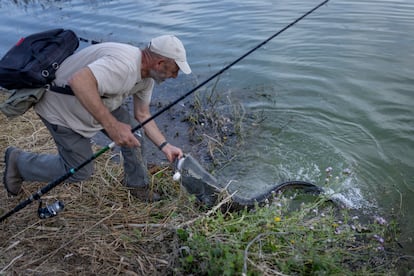
“The fish is not to blame; those responsible are the people who have brought it here,” says fisherman José Manuel García while examining a huge wels catfish measuring 1.6 meters and weighing 25 kilos that he has just caught in the Iznájar reservoir in the Guadalquivir basin in southern Spain, where the species first appeared in 2011. “There are bigger ones,” he says before killing it, as required by law as it is an invasive exotic species . The wels catfish — the largest freshwater fish in Europe, which can reach a length of 2.5 meters and weigh over 120 kilos — has not stopped multiplying and wreaking environmental havoc since the German biologist Roland Lorkowsky introduced 32 fry from the Danube into the Segre river, in the Ebro basin, in 1974.
Since then, the species, which originates from central Europe, has colonized most of the main basins of the Iberian Peninsula. This expansion has been made possible due to fishing enthusiasts transporting it from one place to another illegally and without taking into account the environmental consequences. Other fishermen like García, president of the Environmental Association of Fishermen of the Iznájar reservoir (Amapila), are trying to stop these practices and convince their colleagues of the devastating effects they cause in Spain’s rivers.
In Iznájar, native species such as the common barbel and bogue are becoming increasingly scarce, while others, such as carp and black bass, have been introduced. “It is a machine of destruction that eats between 2% and 4% of its body weight every day. It has even been detected that it can catch ducks and geese and other birds such as cormorants, of which we have found remains in its stomach”, says Carlos Fernández, professor of zoology at the University of Córdoba and head of the Stop Catfish program, on the shore of the reservoir. This research, promoted by the Ministry for Ecological Transition, aims to determine the distribution area of the species in the Lower Guadalquivir and to develop a management plan.
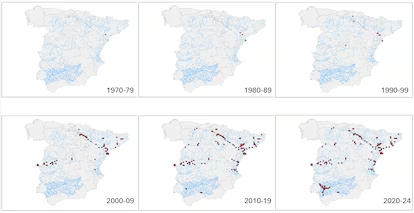
Despite the damage they cause, some fishermen have continued to transport catfish to other areas, despite regulations stating that their capture is only allowed in areas where they were found before the 2007 natural heritage law came into force, such as in the Mequinenza reservoir, in the province of Zaragoza, where a lucrative business has developed around sport fishing for the species. “They want to have [the fish] close to where they live,” says the president of Amapila.
“There are people who think that the introduction of species increases diversity and local wealth, but what is produced is a global loss ,” explains biologist and University of Girona professor Emili García-Berthou, an expert in inland fish. These new inhabitants — in this case the catfish — cause the disappearance of native communities and fauna and flora to become increasingly similar between countries.
Amapila fishermen are aware of this loss of diversity. “We miss the times when we used to catch 20 or 30 barbel. Now, if we catch one, we are happy,” says García, while measuring the catfish he has just pulled out of the water in Iznájar. When they catch a specimen, they collect all the information available to them: size, diet, whether it is male or female, which they then send to the researcher Carlos Fernández.
The Amapila association has the permission of the Andalusia regional government to extract catfish from the marsh and thus help to contain them, with similar agreements in place with the Association for Fish and Aquatic Ecosystem Conservation (Acpes). However, the fishermen who are trying to solve the problem created by others complain that they are doing it with their own means. “The only thing we have received from an administration were some mortuary bags that the city council of Rute gave us, but two catfish fill them up and you can’t put them in the car; you’d never get rid of the smell,” says García.
As he speaks, the catfish, with its head, wide and flattened, small eyes, two large whiskers and mucous-covered skin, lies still on the ground. “What a useless death. The fishermen who allowed them to expand should see it,” says another Amapila member. Catfish can modify the ecology of an area, warns Fernández. In the Guadalquivir, it threatens the breeding and fattening area of numerous species of commercial interest ( anchovies , sea bass, corvinas, red crab) that are exploited in the Gulf of Cádiz, according to the research carried out by Stop Catfish.
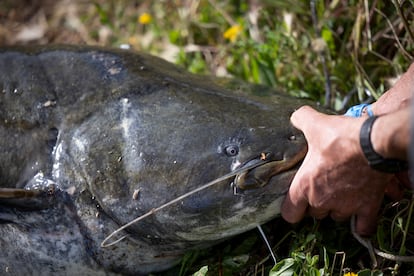
Stopping the advance of the catfish, an almost impossible mission
“The only solution is to eradicate the species in time,” says Fernández, something that was not achieved in Iznájar and many other places in Spain. “It is impossible to stop the advance of an invasive species like the catfish only with what fishermen can catch, without any scientific method or planning,” he adds. In the Guadalquivir basin, the scenario became more complicated in 2017, when two specimens appeared in the Rivera de Huelva river, a tributary of the Guadalquivir. Someone had released them into the waterway. “After collecting data, we have found that the problem is everywhere,” says Fernández. “Maybe some habitats are not suitable for the species and it will die, but in the meantime it will be eating and damaging the ecosystem.”
Amapila fishermen say it is not even an attractive animal to catch. “All you do is pull, pull, pull, as if you were taking the plug out of the marsh. It’s not like the barbel or black bass, which pulls, loosens, you give it reel, it makes its runs...” There are other enthusiasts, however, who enjoy the struggle of catching the huge fish and even travel from other European countries to do so in the few places where it is allowed. However, there is also poaching and illegal trafficking. In 2019, the Spanish Civil Guard arrested 23 people for the illegal fishing of 13 tons of catfish and carp in the Ebro, whose destination was Romania and other eastern European countries.
Disaster for sport fishing
“The Tagus has been greatly affected. Extremadura is a paradise for freshwater fishing, there are trout, cyprinids, native fish of all kinds and the catfish does a lot of damage,” says Miguel Bonifacio, president of the Extremadura Fishing Federation. “You realize that you are no longer catching native fish and that is a disaster for sport fishing, because the places where we can hold competitions, which bring money to the towns, are fewer and fewer,” he says.
For Bonifacio, there is no solution once the species has a foothold. “It is necessary to police the people who catch them to move them somewhere else, it is ignorant behavior.” He asks the administrations not to look the other way. “The hot spots where people go to catch them are perfectly well known. As soon as they start handing out fines, the story is over,” he concludes.
Sign up for our weekly newsletter to get more English-language news coverage from EL PAÍS USA Edition
More information
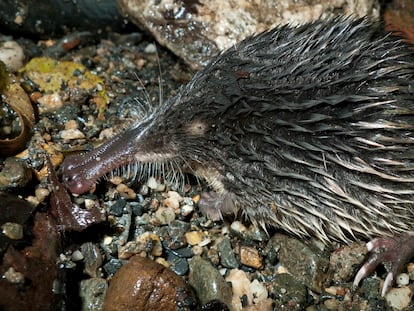
A rare mammal with a trunk-like snout and webbed feet: The Iberian desman faces extinction
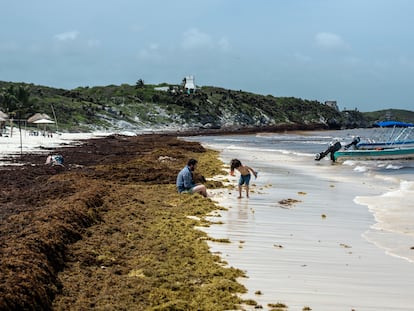
A decade of sargassum damage is suffocating Caribbean ecosystems
Archived in.
- Francés online
- Inglés online
- Italiano online
- Alemán online
- Crucigramas & Juegos

Proposed Reclassification of the Humpback Chub from Endangered to Threatened

DENVER — Things are looking up fora rare Colorado River fish, the endangered humpback chub. The U.S. Fish and Wildlife Service (Service) recently completed a species status assessment (SSA) and a 5-year status review that concluded the current risk of extinction is low, such that the species is not in danger of extinction throughout all of its range. The SSA explained that the largest population of humpback chub, which is found in the Colorado and Little Colorado rivers in the Grand Canyon of Arizona, is a stable population of about 12,000 adults.
Our SSA also explained that four smaller populations in the Green and Colorado rivers of the upper Colorado River basin have persisted and do not appear to be in immediate danger of extinction. All five populations are wild, persisting without the need for hatchery stocking. These population-monitoring results, when coupled with ongoing flow management and nonnative predatory fish control, mean that the humpback chub will be considered for reclassification from endangered to threatened in the next year.
Although this unique fish is making a big step toward recovery it still needs help. Conservation work by a diverse group of stakeholders has been one of the key contributions in recovering this native fish. State, tribal, federal, and private stakeholders collaborate via the Upper Colorado River Endangered Fish Recovery Program (established in 1988) and the Glen Canyon Dam Adaptive Management Program (established in 1997) to continue the monitoring programs and to reduce threats to this species’ recovery. “Endangered species recovery in altered and heavily managed ecosystems like the Colorado River is a complicated endeavor,” said Service Mountain-Prairie Regional Director Noreen Walsh. “Our best chance for continued success rests in the power of these collaborative partnerships.”
The humpback chub, which was first described as a unique species from collections in the Grand Canyon in the 1940’s, was not discovered in the upper Colorado River basin until the 1970’s. It was placed on the original list of endangered species in 1967. Humpback chub prefer canyon-bound reaches of river where they complete their life cycle in swift, turbulent currents. The species gets its name from the fleshy hump behind its head. That adaptation coupled with large, curved fins allows the species to maintain position in the turbulent flows. Habitat alterations (from changes in river flows and inundation of canyon reaches), and competition and predation from invasive species invasive species An invasive species is any plant or animal that has spread or been introduced into a new area where they are, or could, cause harm to the environment, economy, or human, animal, or plant health. Their unwelcome presence can destroy ecosystems and cost millions of dollars. Learn more about invasive species are the greatest threats to the humpback chub.
In the 5-year review, the Service also recommends that the species recovery plan be revised to incorporate the best available scientific information on the species needs and actions that will be necessary to eventually delist humpback chub. Efforts to propose reclassification and to revise the recovery plan will be ongoing in the coming year. The proposed reclassification rule and the revised recovery plan will be made available for public comment in the future.
The mission of the U.S. Fish and Wildlife Service is working with others to conserve, protect, and enhance fish, wildlife, plants, and their habitats for the continuing benefit of the American people. For more information on our work and the people who make it happen in the West, connect with us through any of these social media channels: Facebook , Twitter , Flickr , YouTube , and Instagram .
Latest Press Releases
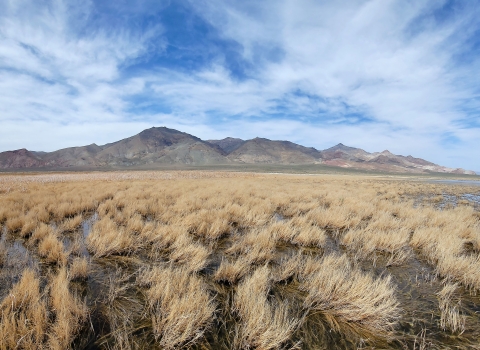
You are exiting the U.S. Fish and Wildlife Service website
You are being directed to
We do not guarantee that the websites we link to comply with Section 508 (Accessibility Requirements) of the Rehabilitation Act. Links also do not constitute endorsement, recommendation, or favoring by the U.S. Fish and Wildlife Service.
Animals are in danger of extinction. Some people say that we should protect only those animals, which are useful to humans. Do you agree or disagree?
Unauthorized use and/or duplication of this material without express and written permission from this site’s author and/or owner is strictly prohibited. Excerpts and links may be used, provided that full and clear credit is given to Writing9 with appropriate and specific direction to the original content.
Fully explain your ideas
To get an excellent score in the IELTS Task 2 writing section, one of the easiest and most effective tips is structuring your writing in the most solid format. A great argument essay structure may be divided to four paragraphs, in which comprises of four sentences (excluding the conclusion paragraph, which comprises of three sentences).
For we to consider an essay structure a great one, it should be looking like this:
- Paragraph 1 - Introduction
- Sentence 1 - Background statement
- Sentence 2 - Detailed background statement
- Sentence 3 - Thesis
- Sentence 4 - Outline sentence
- Paragraph 2 - First supporting paragraph
- Sentence 1 - Topic sentence
- Sentence 2 - Example
- Sentence 3 - Discussion
- Sentence 4 - Conclusion
- Paragraph 3 - Second supporting paragraph
- Paragraph 4 - Conclusion
- Sentence 1 - Summary
- Sentence 2 - Restatement of thesis
- Sentence 3 - Prediction or recommendation
Our recommended essay structure above comprises of fifteen (15) sentences, which will make your essay approximately 250 to 275 words.
Discover more tips in The Ultimate Guide to Get a Target Band Score of 7+ » — a book that's free for 🚀 Premium users.
- Check your IELTS essay »
- Find essays with the same topic
- View collections of IELTS Writing Samples
- Show IELTS Writing Task 2 Topics
parents should spend more time helping their children with homework. do you agree or disagree? give reasons for your answer
Some people say that in the modern world, getting old is entirely bad. others, however, say that life for the elderly nowadays is much better than it was in the past. discuss both views and give your own opinion., many parents today do not spend much time with their children. why is this does this affect parents or children more, global warming is one of the most serious issues that the world facing today. what are the causes of global warming and what measures can government and individuals take to tackle the issue., many people drive personal vehicles to school and work. what are the advantages and disadvantages of this type of transportation discuss both and give your own opinion..

IMAGES
VIDEO
COMMENTS
This essay will present arguments in support of my opinion. To begin with, I believe that a large number of endangered animals are due to human activities. For instance, deforestation and burning forest are two major factors that have driven dozens of species to extinction. Therefore, there is nothing more just than to protect those animals ...
An endangered species is a type of organism that is threatened by extinction.Species become endangered for two main reasons: loss of habitat and loss of genetic variation. Loss of Habitat A loss of habitat can happen naturally. Nonavian dinosaurs, for instance, lost their habitat about 65 million years ago.The hot, dry climate of the Cretaceous period changed very quickly, most likely because ...
While there have been amazing and inspirational wildlife successes and stories in the past, many animals are still endangered mostly due to unsustainable human-led activities. Currently, on the International Union for Conservation of Nature (IUCN) red list, more than 41,000 species have been assessed to be under threat of extinction.
May 06, 2019. • 9 min read. The bonds that hold nature together may be at risk of unraveling from deforestation, overfishing, development, and other human activities, a landmark United Nations ...
Find below the band 8 sample answer for writing task 2 on, "Animals are in danger of extinction.". This Agree or Disagree Essay is a part of Writing Task 2 of the IELTS and is discussed here with an outline and vocabulary that will help you to prepare. Learn some more Ways to achieve a band score of 8 for Writing Task 2 and check out the ...
Extinction of Animals Essay Sample. You should spend about 40 minutes on this task. Write about the following topic: It is a natural process that animal species become extinct, as the dinosaurs did in the past. There is no reason for people to prevent this from happening.
An animal is called endangered when there are so few of its kind left that it is in danger of becoming extinct — disappearing from the world forever. There are many reasons that animals and plants can become endangered or die out altogether. Since Earth began 4.5 billion years ago, it has been continually changing. Most often, this change is ...
An endangered species is an animal or plant that's considered at risk of extinction. A species can be listed as endangered at the state, federal, and international level. On the federal level, the endangered species list is managed under the Endangered Species Act. The Endangered Species Act (ESA) was enacted by Congress in 1973.
Even the extinction of a single wild species can disrupt the entire food chain, resulting in severe consequences. Consider the basic example of a bee, which is necessary for the growth of particular crops due to its pollen transport functions. Due to a lack of pollination, the growth of food crops would suffer if bees were to go extinct.
Up to one million plant and animal species face extinction, many within decades, because of human activities, says the most comprehensive report yet on the state of global ecosystems. Without ...
The Endangered Species Act requires that every U.S. plant and animal be saved from extinction, but after 50 years, we have to do much more to prevent a biodiversity crisis. By Robert Kunzig. Snail ...
Extinction is the termination of a certain living form, usually a species, or a language. The death of the last individual of the species (or the last speaker) is considered to be the moment of extinction. This phenomenon of animal extinction s considered to be the world's largest threat to wildlife. In the last 50 years, the wildlife ...
Environment: Endangered Species Essay. Globally, over 14,000 animal species face a risk of extinction. The reasons for the near extinction include poaching, habitat loss, human-wildlife conflict, pollution, diseases, climate change, and low birth rates (IUCN, 2021). Some of the most endangered species include the Javan rhino, African elephants ...
Published: Dec 16, 2021. From 41,415 animal species, 16,306 of them are facing extinction according to IUCN's Red List. Some of these animals are the Amur Leopard, the Orangutan, the Hawksbill Turtle, the African Wild Dog, and many more. It is our job to protect these animals because of their vital roles in our ecosystem.
The role of humans . In shedding more light on co-extinctions, UNU said that intense human activities, such as land-use change, overexploitation, climate change, pollution and the introduction of invasive species, is causing an extinction acceleration that is at least tens to hundreds of times faster than the natural process of extinctions. In the last 100 years, over 400 vertebrate species ...
explain why I believe that all. species. existed for some crucial purpose and that we should be protected from all of them. First. , I believe a large number of. animals. which is in danger of extinction are due to human activity. For example. , deforestation and intentional burnings are two of the main factors that made dozens of.
But wild. animals. are. also. a part of the environment. In the environmental ,cycle every animal are depending on another one, one way or another. We know that deer feed from the grass or tree and it becomes food for the line. After the death of a wild animal its prey mixed with the soil of the earth. This.
It is an undeniable fact that many animal. species. are in danger of extinction. So, some people believe that humans only conserve those animals, which are beneficial for them, whereas others argue that all animals are important and they play their role in the ecosystem either directly or indirectly. I cent per cent agree with the latter view.
Animals that are in the most danger of extinction are classified as "critically endangered," meaning they face the highest risk of extinction in the wild. The animals listed in this provided sample essay by Ultius are in the highest danger of becoming extinct than any other animal species on earth. Which animals are the most endangered?
Many animals are indeed threatened by the risk of extinction. Some hold a belief that humans only need to safeguard certain species that benefit us. I personally disagree with this point of view because I believe that making efforts on animal conservation should not put people's needs into considera ...
Several species of giant lemurs — some of which grew to gorilla-size proportions, and all of which probably served as key seed dispersers for baobabs — were hunted to extinction around 1,000 ...
0:02. 0:50. Global population trends among 71,000 animal species show nearly half are "sliding toward extinction," some of them at alarming rates, a new study warns. Researchers found 48% of the ...
In recent years, there has been a noticeable trend where many people believe that English will become the only language to be spoken on a global stage due to its prevalence in the tourism industry. In this essay, some merits and demerits of this concept will be examined. 6. band.
Credit: Cell Reports Sustainability (2024). DOI: 10.1016/j.crsus.2024.100082. A new study warns bias towards popular animals in conservation research might see some important, but less spectacular ...
The invasive species, native to the rivers of central Europe, is already found in a large part of the main basins of the Iberian Peninsula and is a danger to native fauna Fisherman José Manuel García lands a catfish in the Iznájar reservoir (Córdoba).
DENVER - After a thorough review of the best-available scientific and commercial information, the U.S. Fish and Wildlife Service (Service) announced that the white-tailed prairie dog is not currently in danger of extinction and is not likely to become in danger of extinction within the foreseeable future. Consequently, the Service has released a 12-month finding stating that the species is ...
Writing Samples /. Band 6. Animal are in danger of extinction. Some people say that we should protect only those animals which are useful to humans. Do you agree or disagree with this. # danger # extinction # people # animals # humans. Many species are on the verge of extinction. While. some people think that humans should only protect.
DENVER — Things are looking up fora rare Colorado River fish, the endangered humpback chub. The U.S. Fish and Wildlife Service (Service) recently completed a species status assessment (SSA) and a 5-year status review that concluded the current risk of extinction is low, such that the species is not in danger of extinction throughout all of its range. The SSA explained that the largest ...
creatures. should be conserved those are beneficial for. human. while others find it challenging to concur advocating with it. I endorse wholeheartedly. with. the latter view. This. essay would attempt to explicate my point of view with reasons in the forthcoming paragraph at its.
At Princeton High School, students are trying to combat the rapid decline of indigenous languages with some unlikely help: a furry, wide-eyed stuffed animal named Che'w.